Little Lime Hydrangea — Your Ultimate Guide includes planting, growing and pruning tips, companion plant ideas, inspiring images and videos.
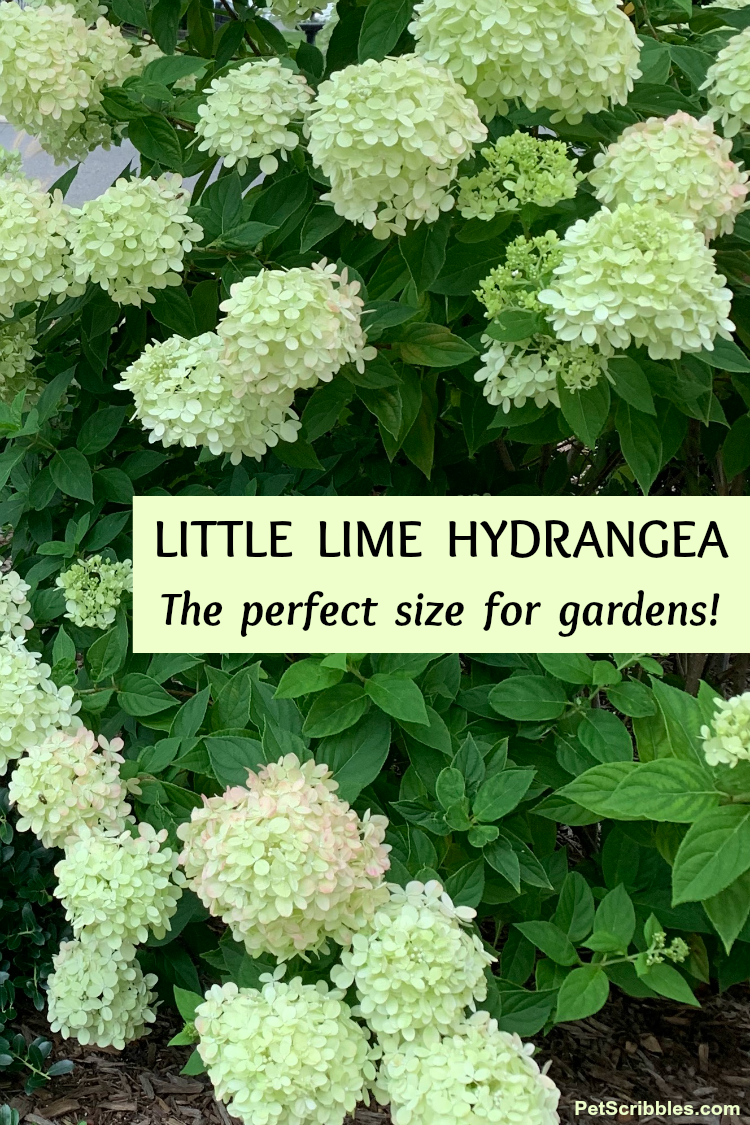
Move over Limelight Hydrangea as there’s a new kid in town!
Little Lime Hydrangea is a dwarf form that is a better size for gardens.
This Summer-flowering shrub has the same stunning flowers as its big brother, and the flower show extends well into the Fall season.
Table of Contents
- What is a Little Lime Hydrangea?
- Why You Want Little Lime In Your Garden
- Is Little Lime Hydrangea Deer Resistant?
- The Difference Between Little Lime and Limelight Hydrangeas
- Shrub Size, Growth and Habit
- Little Lime Leaves and Flowers — Shape, Size, Color and Bloom Time
- Growing Requirements
- Planting Little Lime Hydrangeas
- Can I Transplant Little Lime Hydrangeas?
- Pruning Little Lime Hydrangeas
- Best Companion Plants for Little Lime Hydrangea
- Little Lime Hydrangea Images
- Where to buy Little Lime Hydrangeas
What is a Little Lime Hydrangea?
Little Lime hydrangea is a dwarf version of Limelight hydrangea.
It’s much more compact, growing just 3 to 5 feet tall and wide.
Little Lime is a flowering deciduous (not evergreen) shrub.
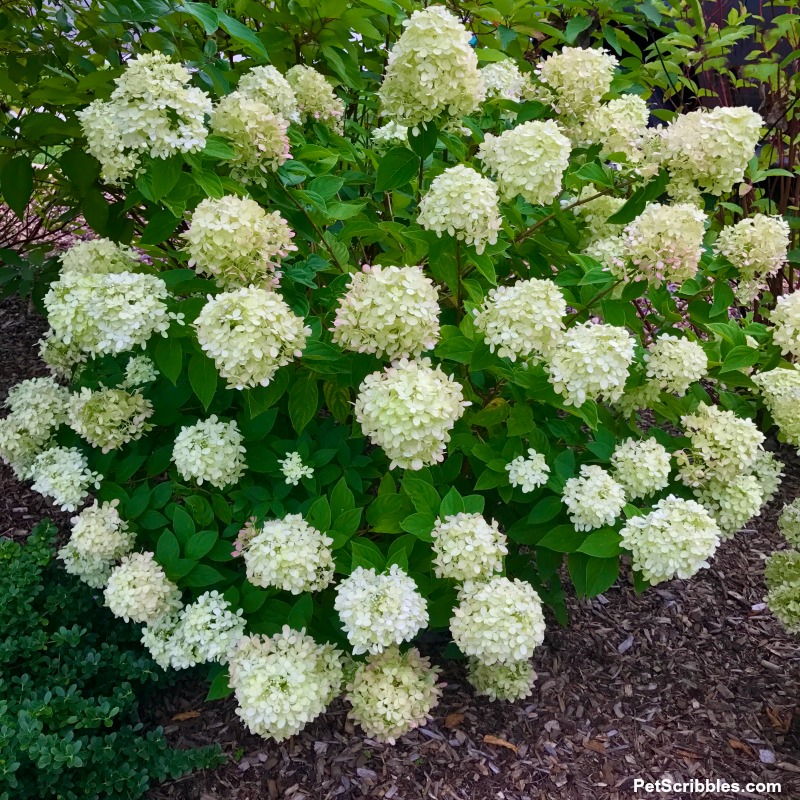
The official name is Hydrangea paniculata “Jane” but it is commonly sold as Little Lime hydrangea.
It’s also known as a Panicle hydrangea.
Panicle hydrangeas are considered the most hardy of all the hydrangea species, which means this Summer-flowering shrub is easy care.
And panicle hydrangeas are great shrubs for beginner gardeners because of how trouble-free they are.
(See my post on Pinky Winky Hydrangeas to learn more about Panicle hydrangeas.)
Why You Want Little Lime Hydrangea In Your Garden
Much more manageable size for gardens
The smaller size of Little Lime fits into gardens much easier than making room for a full-size Limelight hydrangea.
Little Lime’s maximum height and spread is between 3 and 5 feet.
Limelight hydrangeas grow up to 8 feet tall and 6 feet wide.
Perfect for containers and smaller hedges
Little Lime is a great small size for planters and containers.
Group several in a row for a lower hedge or border.
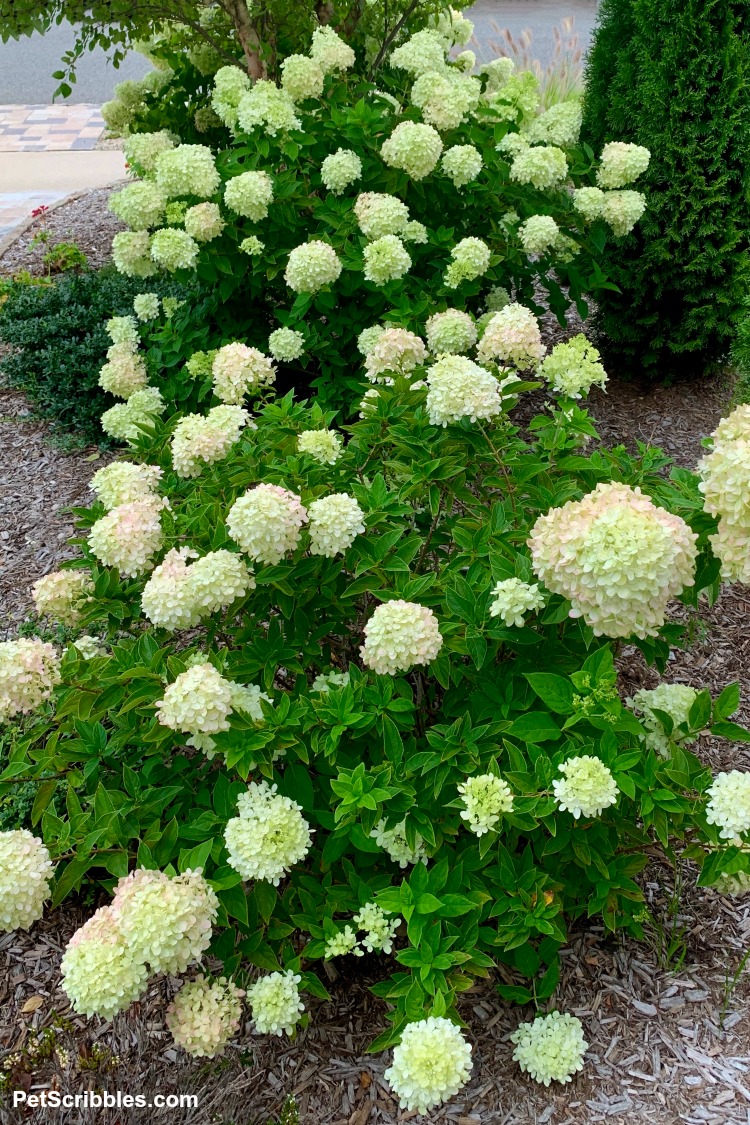
Easy to grow
This is such an easy-care shrub that I am considering planting more of them.
No real pests or diseases to worry about, and they seem to happily bloom their hearts out all season long.
Great for butterfly gardens
Butterflies love hydrangeas, and so do bees.
Little Lime hydrangeas are perfect for pollinator gardens.
Very reliable bloomer
No matter what the Winter weather has been like, our Little Limes come back prettier and bloom like crazy every single year.
Unlike more fragile plants and shrubs, there’s no worry how these flowering shrubs will perform.
Long blooming
The flowers of Little Lime begin to shine in July and stay on the shrub for months, well into the Fall season depending on your climate zone.
Summer AND Fall color
The flowers are an eye-catching pale lime color in the Summer.
About a month later, hints of pink appear.
As the temperatures cool, the flowers continue to change color, eventually becoming a pretty medium pink shade before eventually drying on the shrub.
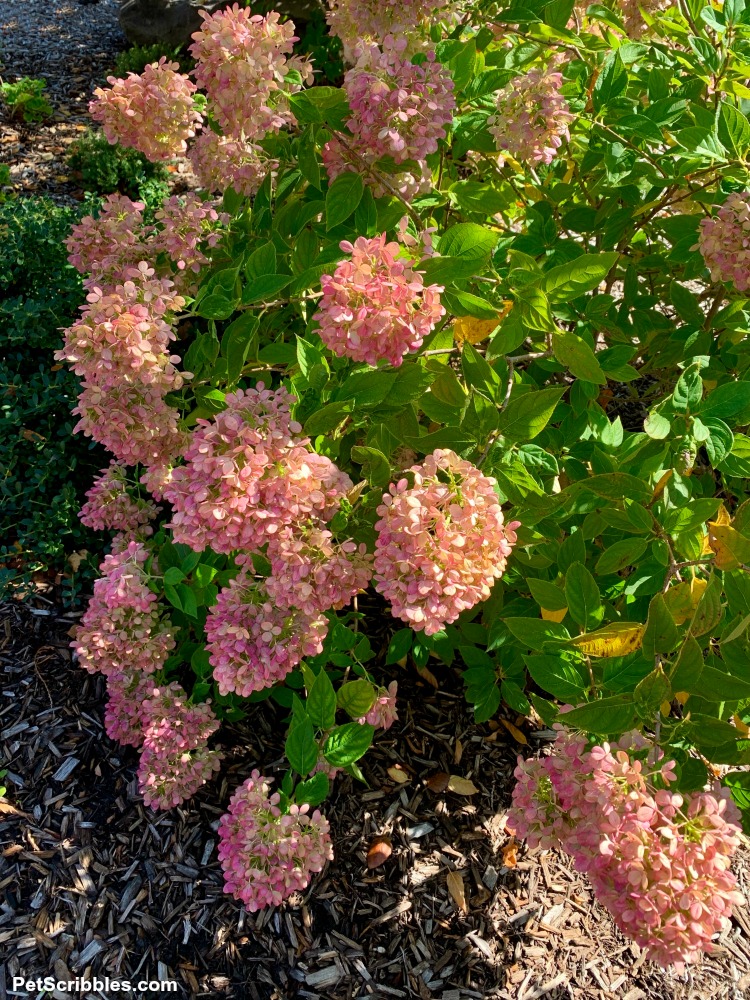
Superb for cut or dried flowers
You can snip a few to enjoy indoors and they will last quite some time, as they begin to dry and take on an almost vintage look.
My favorite, however, are the dried Little Lime flowers, as they dry perfectly without any need for special drying techniques. I let them dry right on the shrubs.
Which brings me to . . .
Winter interest — dried flowers
I keep the dried flowers on the shrubs for Winter interest and color.
They look so pretty, whether against evergreens in the garden or with some snow on top.
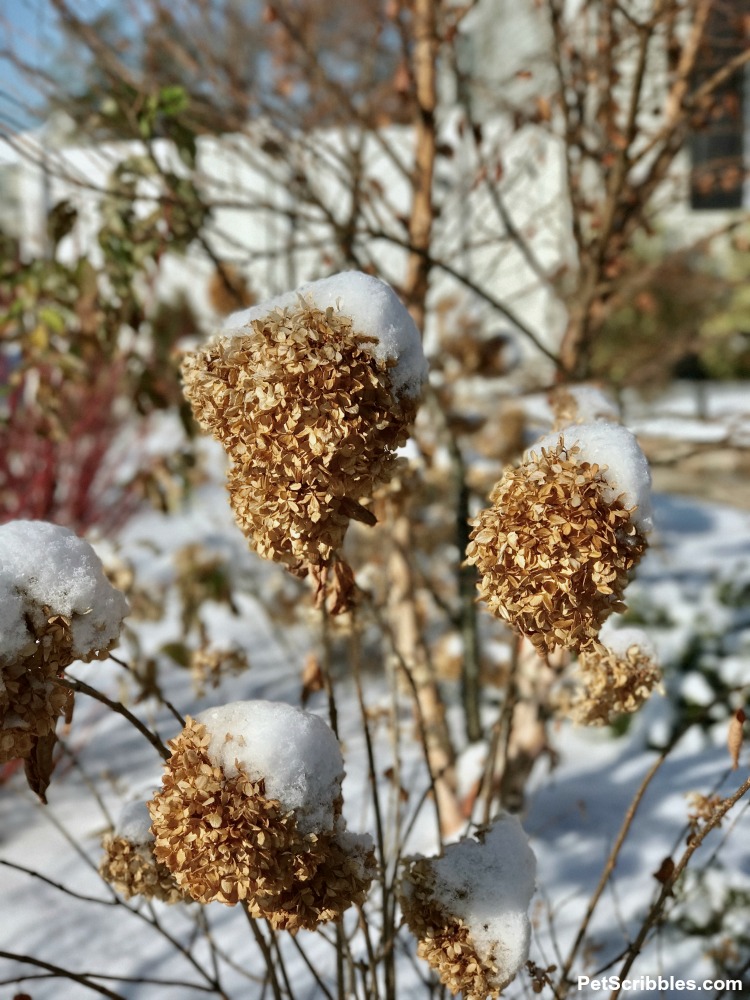
Is Little Lime Hydrangea deer resistant?
Deer will eat just about anything if they are hungry enough and their normal foods are lacking.
Hydrangeas, in general, can be “occasionally severely damaged” by deer according to Rutgers University.
So while hydrangeas aren’t “deer candy” like rhododendrons or evergreen azaleas, they may get nibbled on by deer.
The difference between Little Lime and Limelight Hydrangeas
Size is the main difference between the two shrubs.
Limelight hydrangeas grow up to 8 feet tall and 6 feet wide, while Little Lime hydrangeas stay between 3 and 5 feet tall and wide.
Shrub Size, Growth and Habit
Habit
Little Lime has a rounded habit, with sturdy stems and branches that never get floppy.
The branches hold the flower heads upright all season long.
How big does it get?
The height and width for Little Lime hydrangea is between 3 and 5 feet.
It is approximately 1/3 the size of Limelight hydrangea.
How fast does it grow?
Little Lime hydrangea has a moderate growth rate.
However, I consider it rather fast since I prune mine to about two feet and they grow up and out in one season.
(See the Little Lime hydrangea images further down this page for my own example of growth rate from Spring through Summer.)
Little Lime Hydrangea Leaves and Flowers
Leaves:
The bright green leaves that appear in Spring darken slightly to a medium green.
These leaves are oval in shape and come to a point on the ends.
If you look closely, you’ll see that each leaf has little serrated-looking edges, although they are not at all sharp.
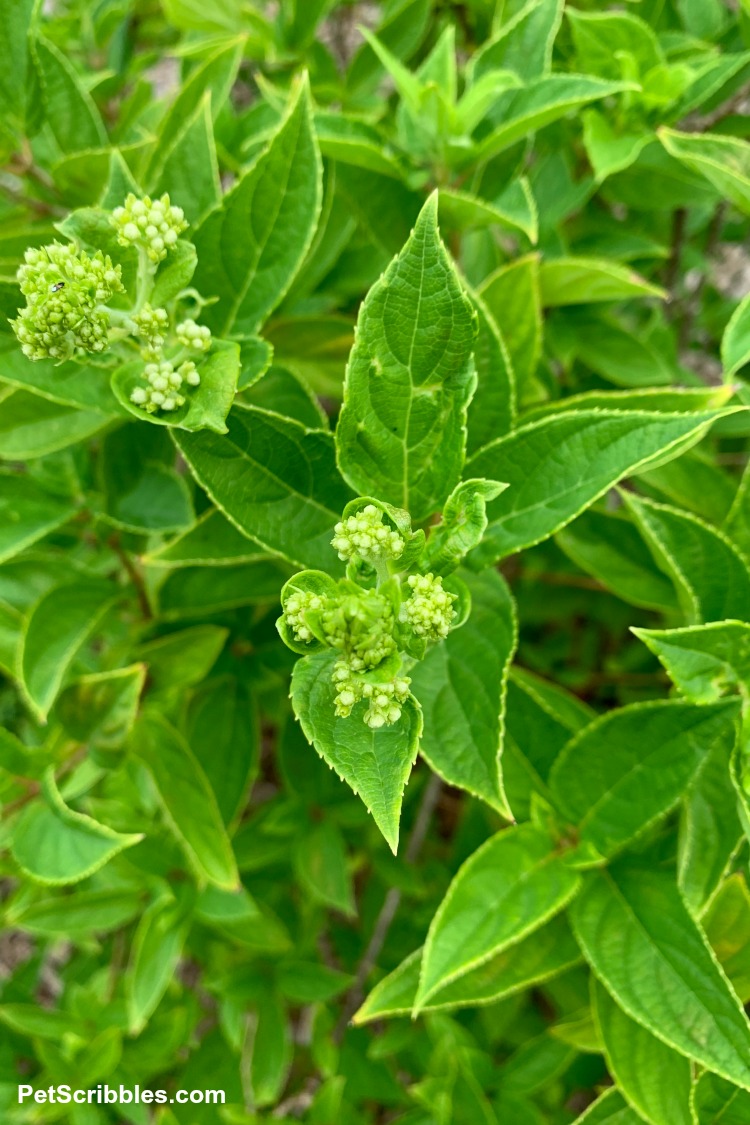
There is no spectacular Fall foliage color, but that doesn’t matter when the flowers are still putting on their show.
(Some nurseries say the Fall foliage is somewhat colorful, but I personally haven’t experienced it.)
Flower shape and size:
The flower heads of Little Lime hydrangea are known as panicles, which usually are cone-shaped, but Little Lime panicles have a bit of rounded mophead shape to them.
These panicles can grow up to 5 inches tall and 4 inches wide.
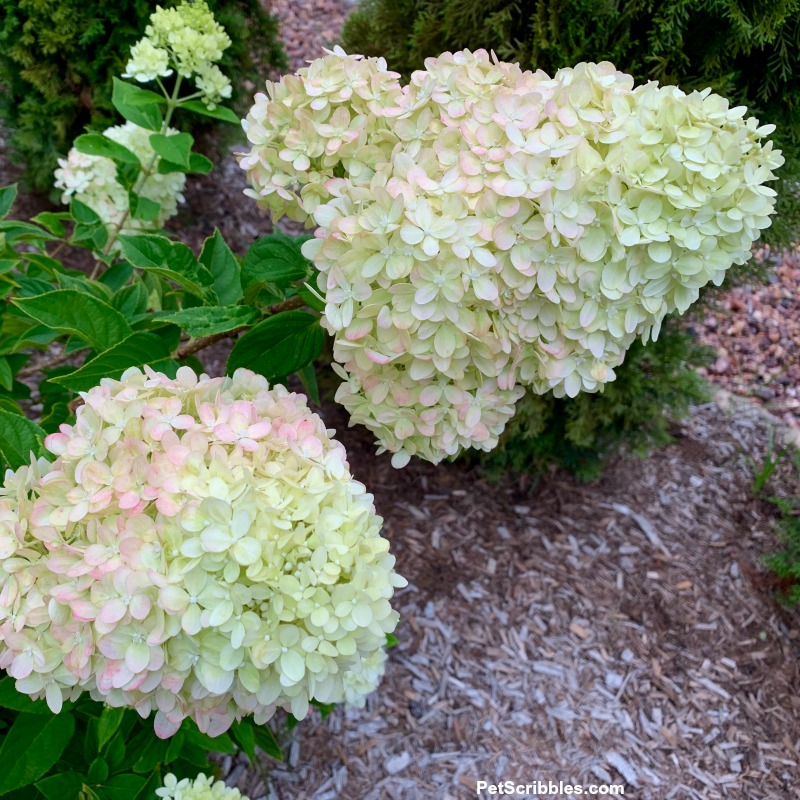
Flower color:
In Spring, the flower buds are lime green:

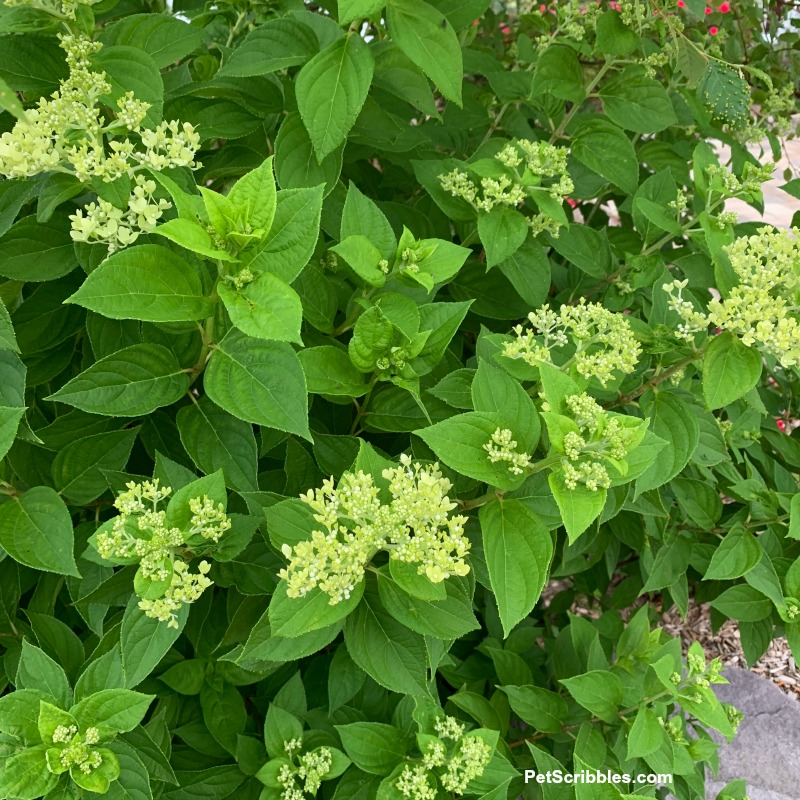
These flower buds develop into flowers with the same pale lime green shade.
Flowers stay this color all Summer.
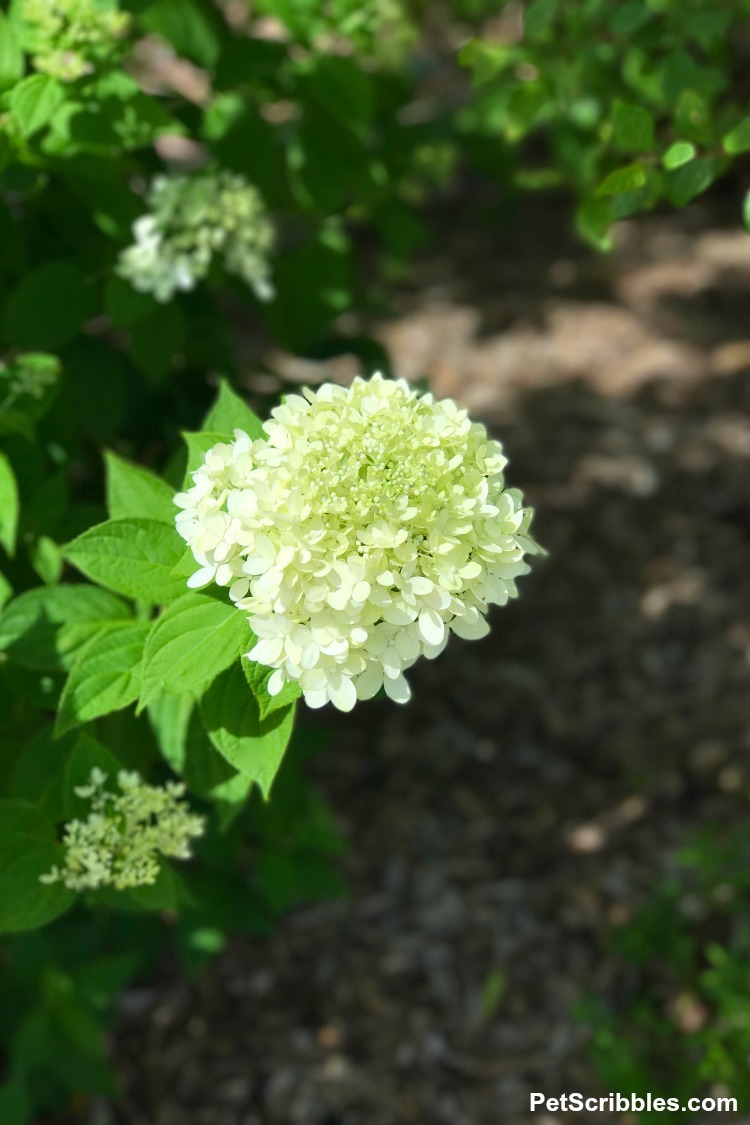
In my experience, some flowers can appear more ivory than lime.
Helpful tip: It doesn’t seem that all nurseries agree on the exact Summer flower color description. It is described as fluffy white, or pale lime, or pretty ivory. Not very helpful, but just know that you can see some of each as I mentioned above.
The blooms take on hints of pale pink as the Summer continues.
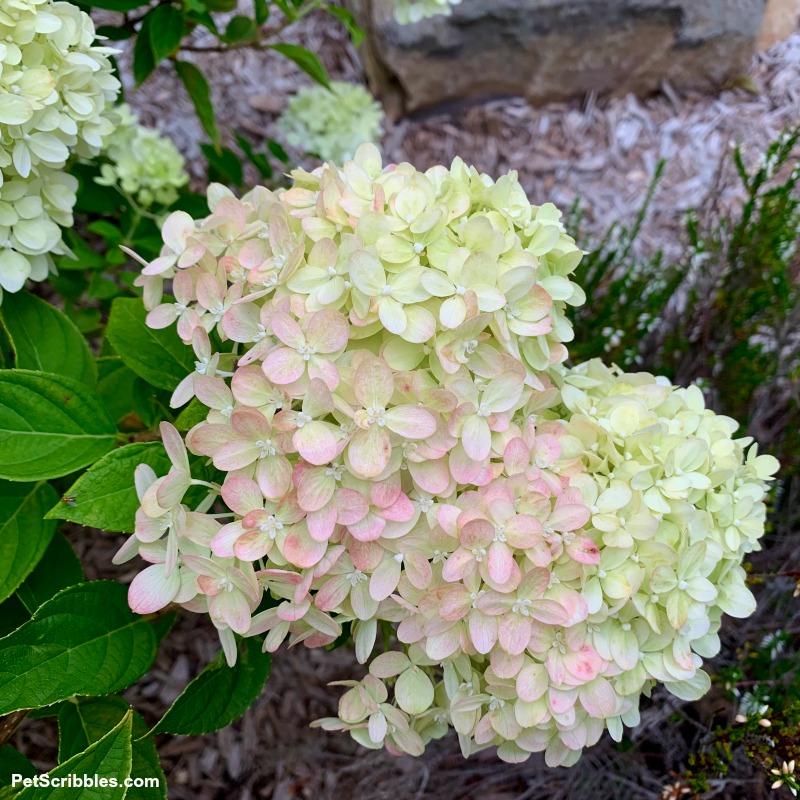
Below are two of our Little Limes next to each other.
Notice how one is pale lime green while the other has begun turning pink.
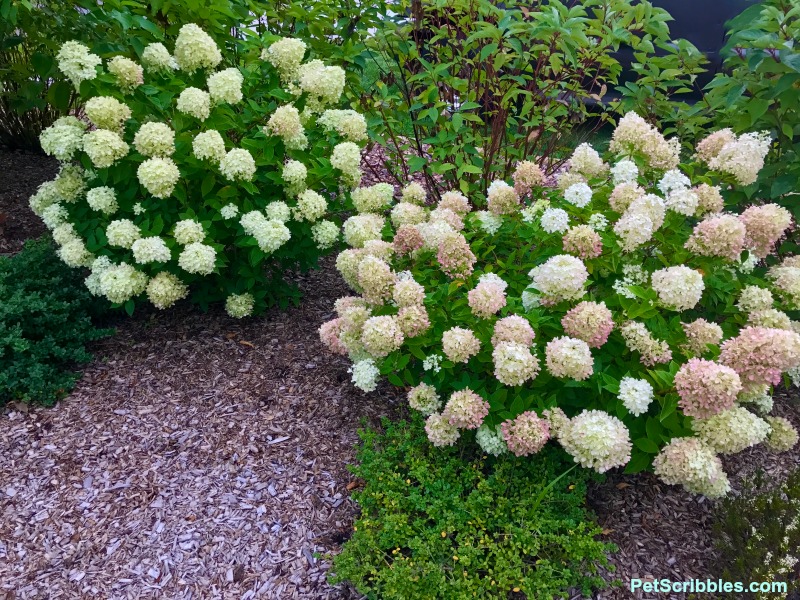
The flowers continue turning darker pink in Autumn as the weather begins to cool.
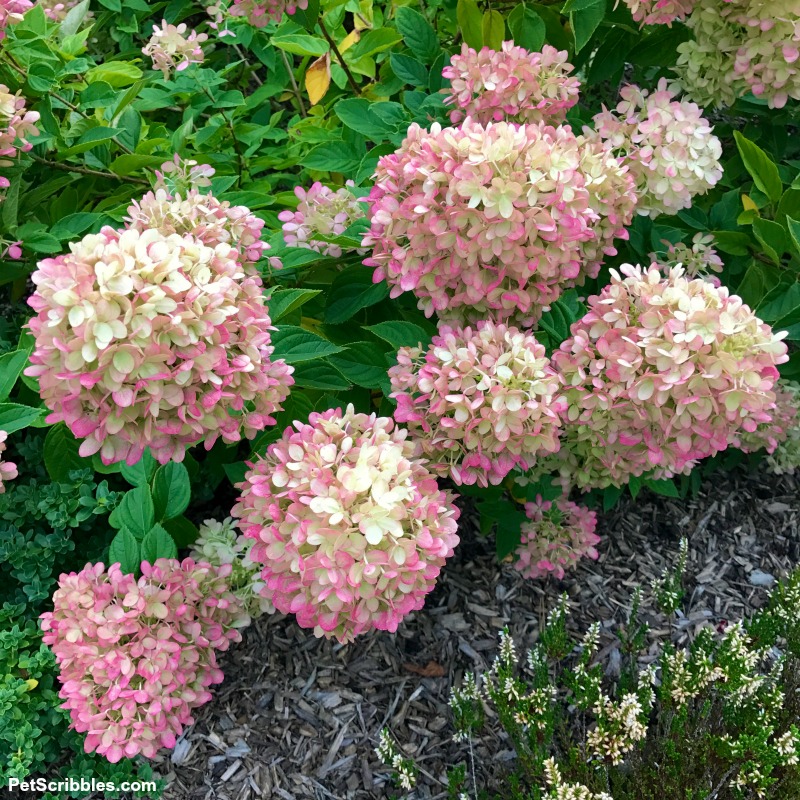
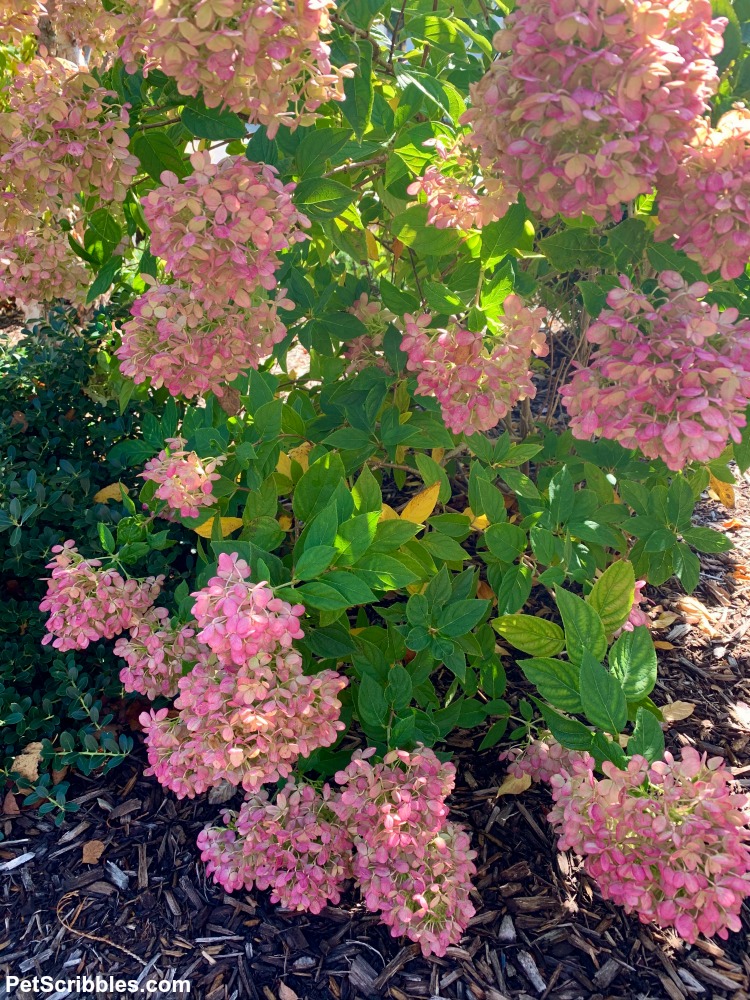
The flowers continue to deepen to a medium pink color, while other flowers may begin to fade in the sunlight.
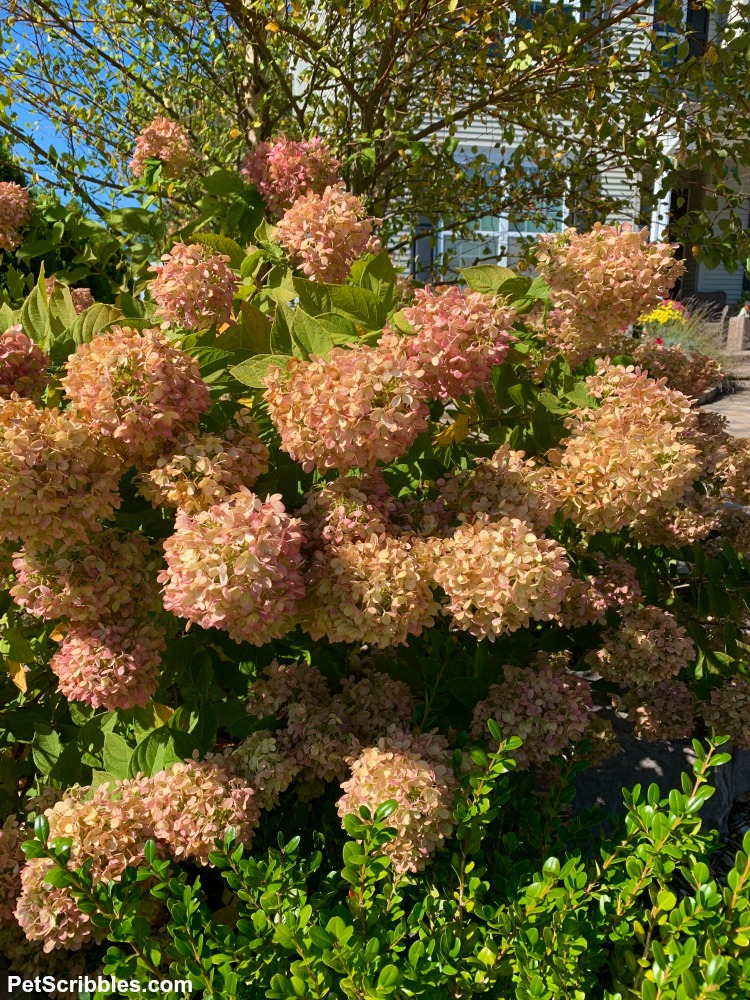
The dried flower heads are a perfect shade of vintage cream with hints of tan.
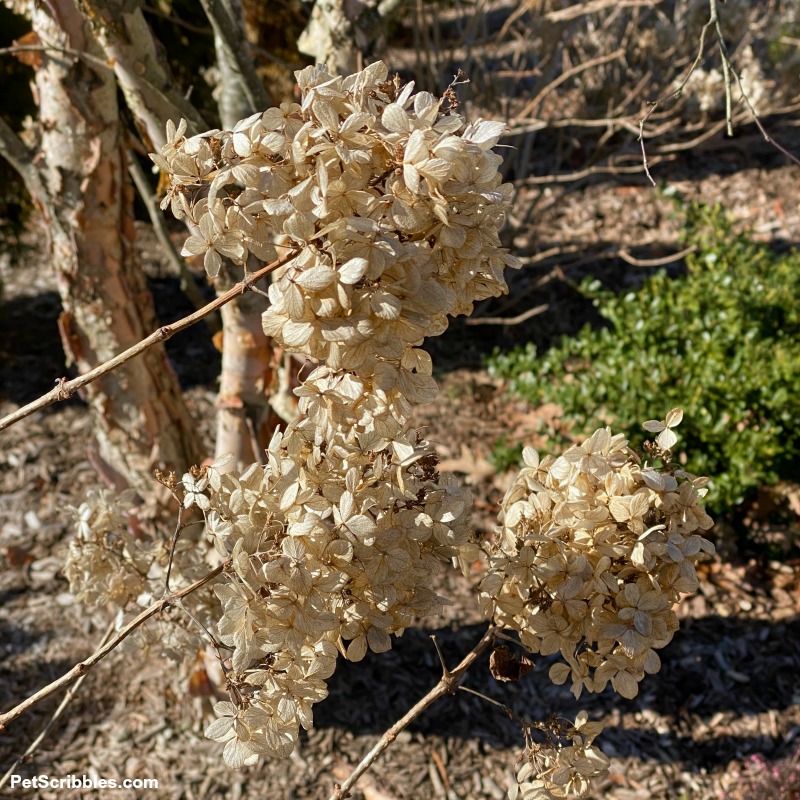
When do they bloom?
Little Lime hydrangea has the same blooming period as its big brother Limelight hydrangea.
It flowers continuously from July until frost.
Helpful tip: The flowers bloom on new wood, so make sure any pruning of the stems is done in late Winter or early Spring. (See pruning information further down this page.)
Growing Requirements for Little Lime Hydrangea
Hardiness:
USDA Zones 3 — 9
Sun:
Little Lime hydrangeas are happiest in either full sun or partial sun.
In the South they will benefit from afternoon shade.
Water:
Water regularly to maintain evenly moist soil that won’t dry out.
These shrubs are drought resistant once established.
You will see the occasional yellow leaf on the shrubs.
You can ignore them unless you see a lot, in which case the shrub is telling you it is thirsty.
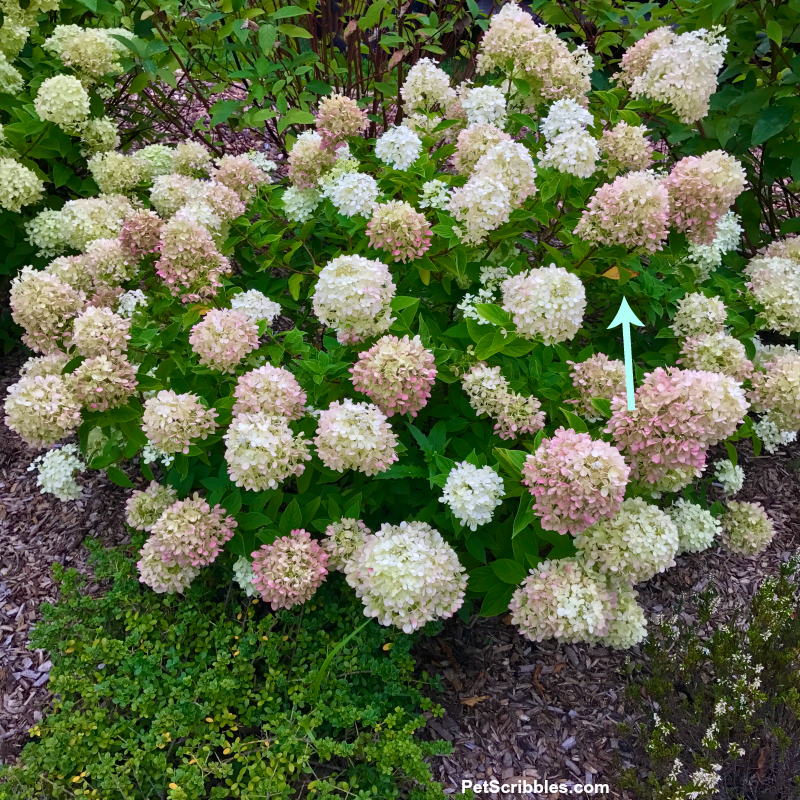
Soil:
Panicle hydrangeas prefer soil on the acid side.
Bloom color is not affected by the soil’s pH.
There is no need for soil amendments like you might add for certain mophead hydrangea varieties to turn them pink or blue.
Fertilizer:
Use an organic, slow-release fertilizer for acid-loving plants in the early Spring.
I use Holly Tone by Espoma.
Some gardeners don’t use any fertilizers on their hydrangeas and still have beautiful shrubs with lots of flowers.
Do not use high nitrogen-based fertilizers, as this can actually hinder flower production on most hydrangea varieties.
Planting Little Lime Hydrangeas
Best time to plant Little Lime Hydrangea
Plant Little Lime hydrangea in the Spring after frost is gone.
You can also plant these shrubs in early Fall, so the roots have time to get established before the Winter season.
How to plant Little Lime Hydrangea
As with most flowering shrubs, do not plant Little Lime hydrangeas too deep.
Dig a planting hole only as deep as the Little Lime shrub is currently planted in its container, and a bit larger than the width [of the container].
Periodically check your work by placing the container into the planting hole to see how high or low the plant is.
Adjust accordingly with more or less soil.
Place the plant into the hole and fill in the sides with more soil.
Mulch to conserve moisture and keep the soil from baking in hot sun.
Little Lime Hydrangea Spacing
Plant Little Lime hydrangea shrubs at least 4 to 6 feet apart.
Can I transplant Little Lime Hydrangeas?
Yes, but wait until the shrub is in a dormant stage, either in early Spring before buds leaf out or late Fall once leaves have fallen off.
If you transplant Little Lime while it is actively growing, the shrub will experience quite a bit of stress and shock.
Pruning Little Lime Hydrangeas
When to Prune Little Lime Hydrangea
Little Lime hydrangea flowers bloom on new wood, so make sure any pruning of the stems is done in late Winter or early Spring.
How to Prune Little Lime Hydrangea
- Give the stems a quick trim from the top, cutting at least a few inches from each stem.
- For complete new growth, cut the stems all the way down to the ground.
- However, if you want taller plants, cut them back to just 1 to 3 feet — which is what I do.
- I’ve read in multiple places that if you cut back stems just leaving two buds at the base of each stem, you will have larger flower heads. (I haven’t personally tried this.)
- Remove any crossing branches — stems that are rubbing against each other — to avoid future problems with pests or disease getting into the branches.
Here is what a Little Lime hydrangea looks like six weeks after pruning:
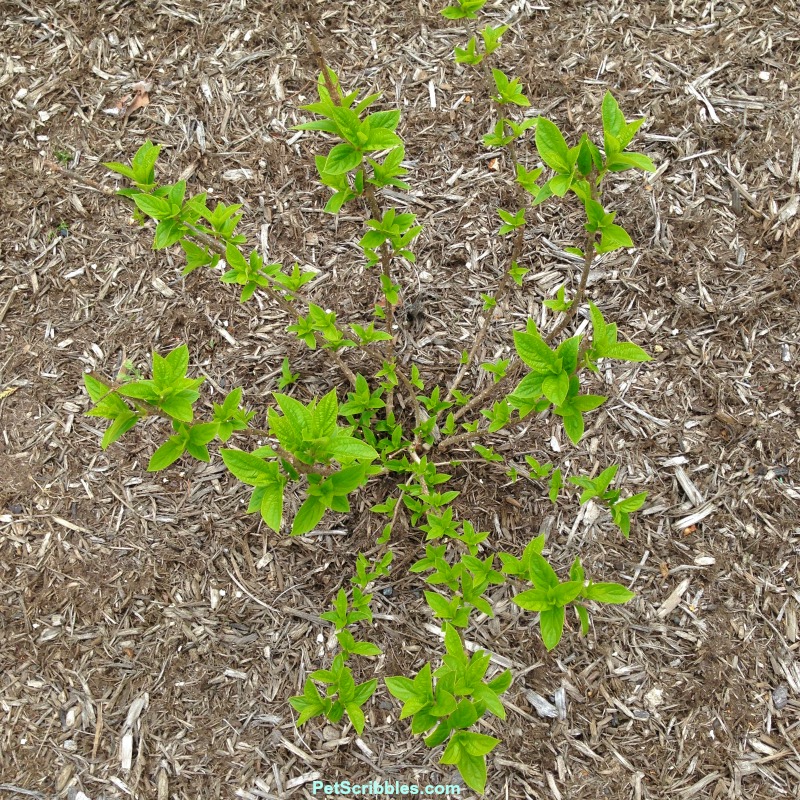
Best Companion Plants for Little Lime Hydrangea
If you have the space, you could plant full-size Limelight hydrangeas behind your Little Lime hydrangeas for a spectacular flower show from the ground up.
Butterflies love Little Limes, so consider plants such as Milkweed, Asters, Salvia, Alliums and Lantana. You can easily go down a rabbit hole by looking up plants that butterflies love!
Evergreen plants look nice in front and behind these shrubs, as accent plants during the Summer.
This is a Winter-blooming Heath in front:
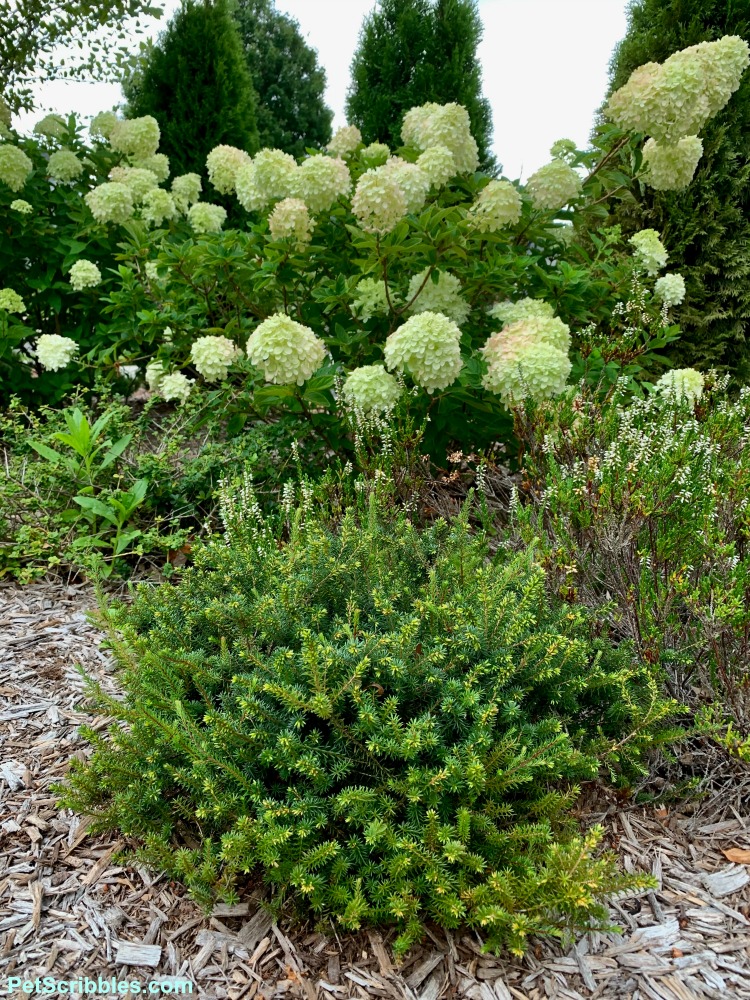
In Winter, tall evergreens behind Little Limes show off the pretty dried flowers left on the shrubs, while short evergreens in front of the plants provide much-needed Winter color.
Since the blooms of Little Lime won’t pop out until late June at the earliest, plant colorful early-blooming, shorter annuals or perennials in front to provide garden color.
Violets, ageratum, geraniums, ajuga, liriope, dianthus, impatiens . . . again do a little homework and you will find some of your own favorites to plant.
Little Lime Hydrangea Images
To give you a better sense of the growing timeline in my particular zone (7), here are images from Spring through Winter.
Spring
April 30: The blue arrows point to three Little Limes with new leaf growth emerging.
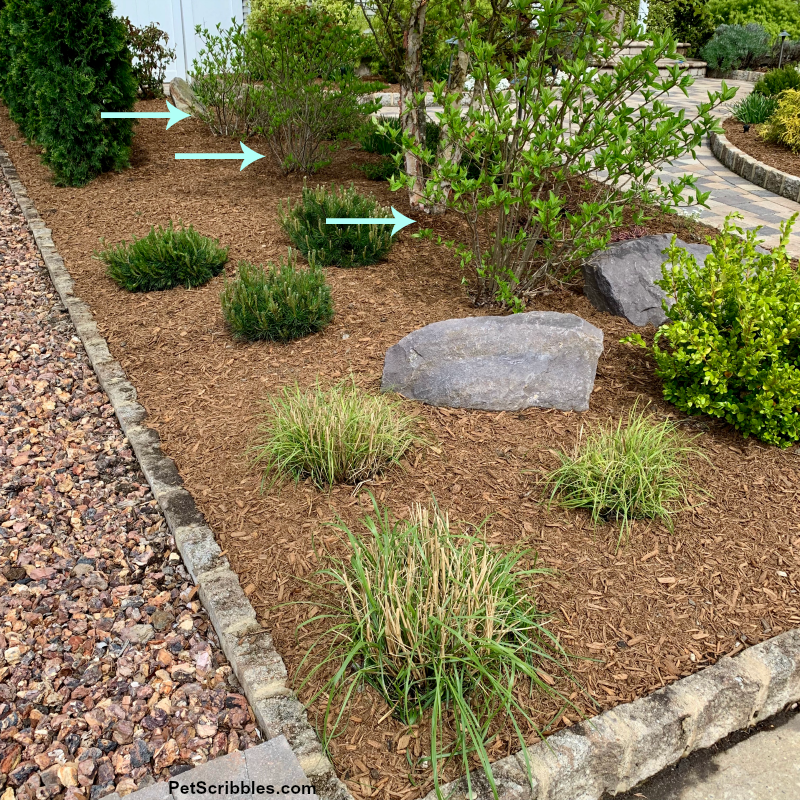
Summer
June 5: The same garden, with bright green leaves.
There’s new growth on the Mugo pines and Little Bunny ornamental grass, and the Knockout Roses are blooming in the background.
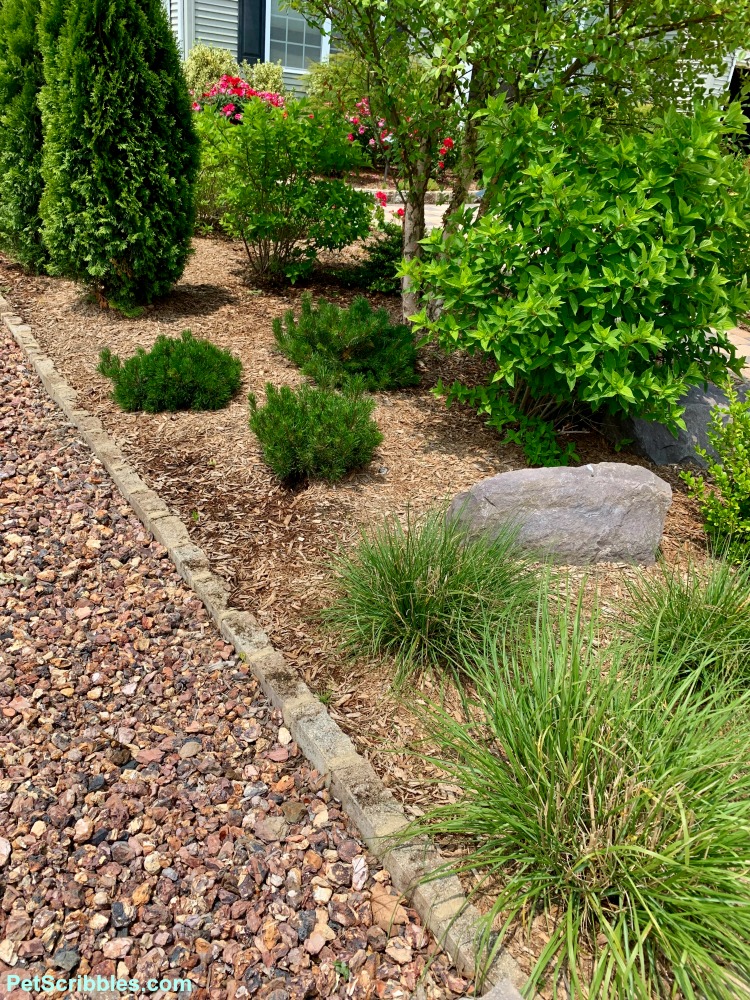
July 11: The hydrangea flower buds appear all over the shrubs.
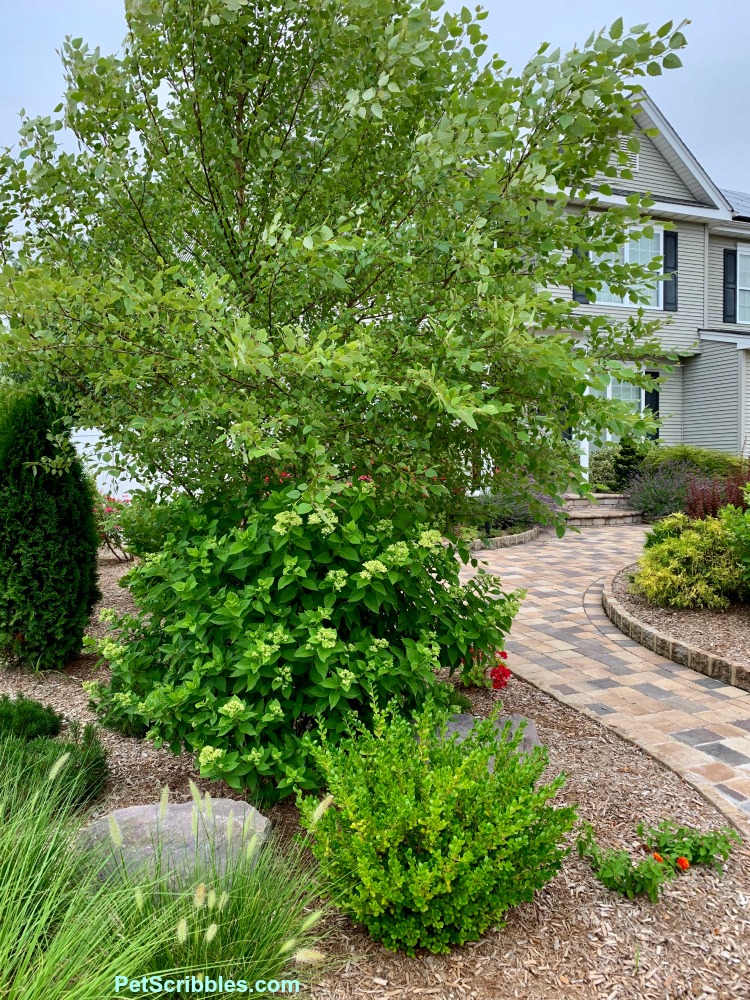
August 13: These pretty shrubs are in full bloom!
The flowers opened up by the last week in July.
Notice how much larger the shrub appears once the fluffy panicles are flowering — compare the previous image with the one below.
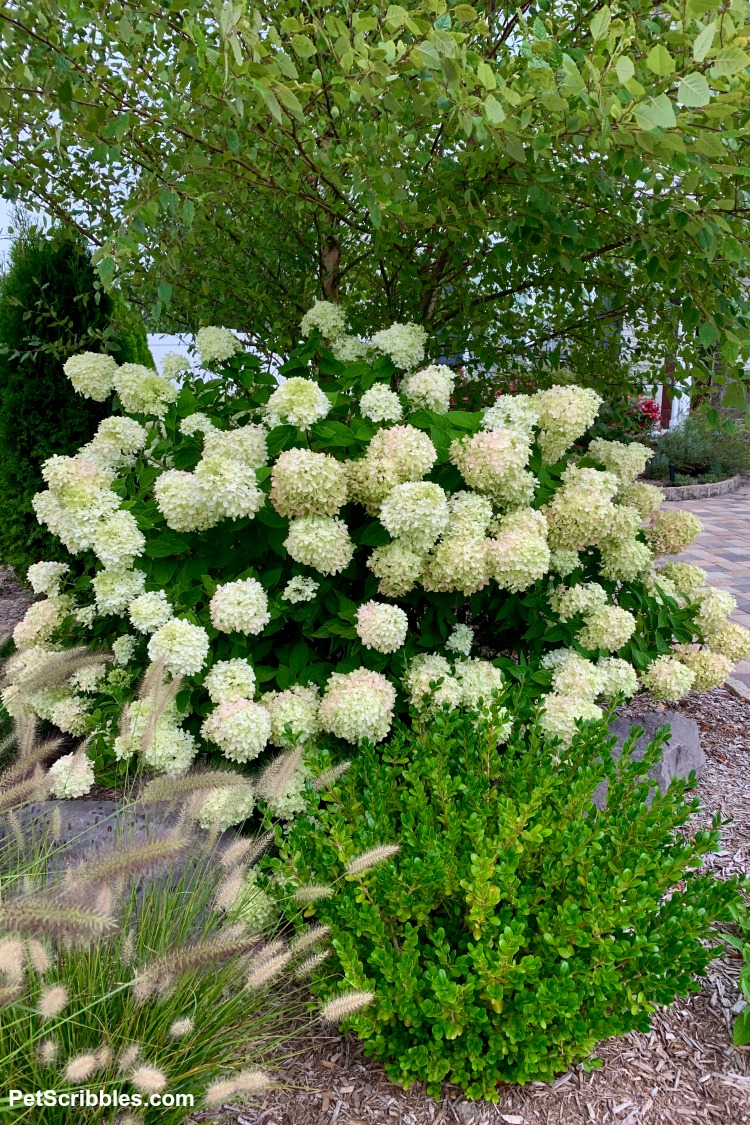
I love the pale pink River Birch bark surrounded by lime green flowers!
The small evergreen shrub is Helleri Holly.
This scene is so charming!
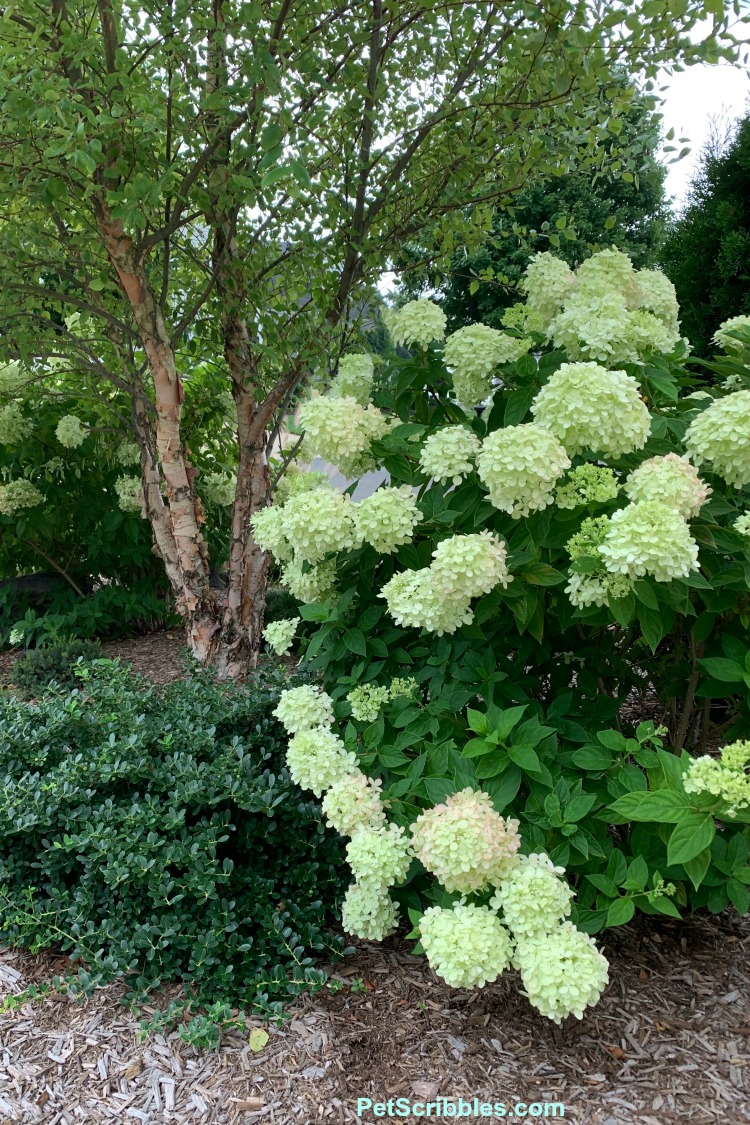
Fall
September 1: There is a lot of pink color on the flower heads.
That’s a Summer-blooming white Heather in front.
(Actually that particular Heather isn’t sure when it’s supposed to bloom, as it seems to have some flowers on it year-round!)
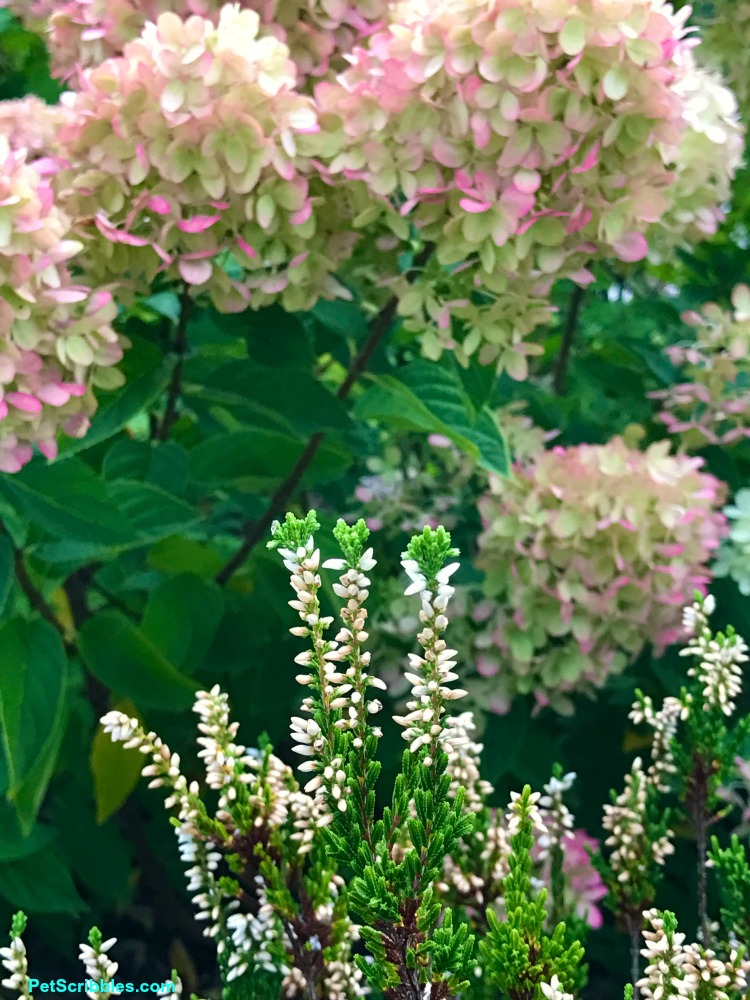
October 14: The flowers are mostly pink now, and just breathtaking!
You can also see some of the leaves have turned yellow.
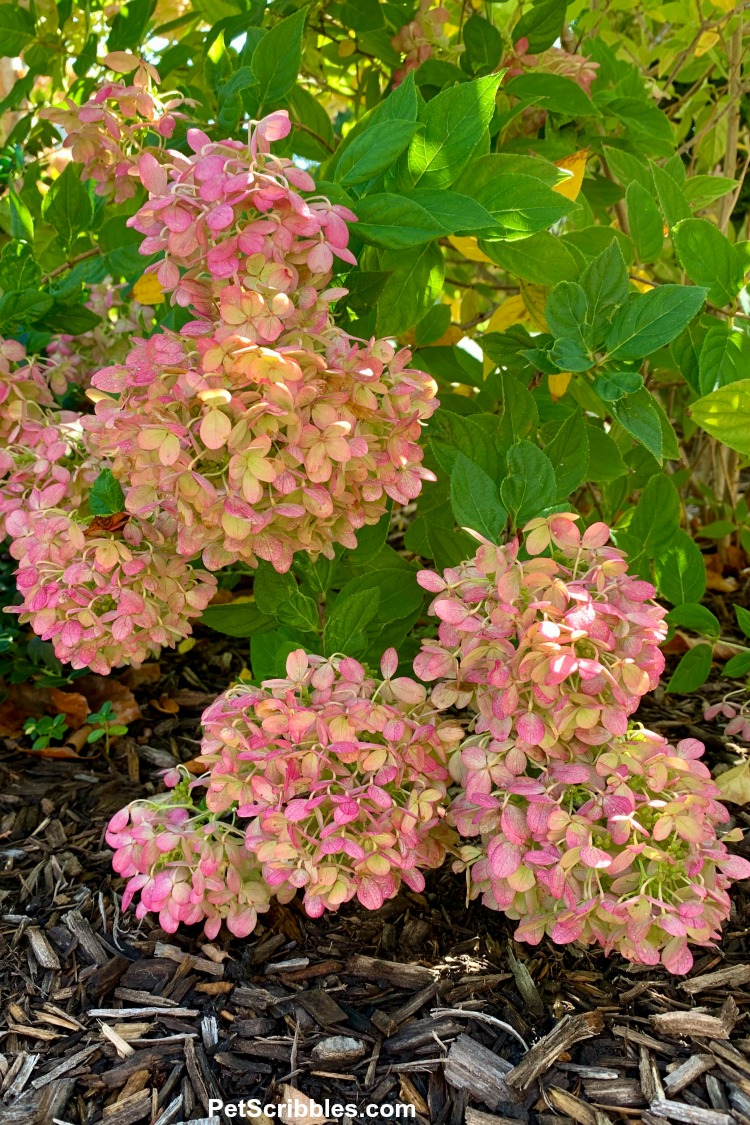
I photographed this from our second floor early one morning, to try and capture the pretty color of the drying flowers.
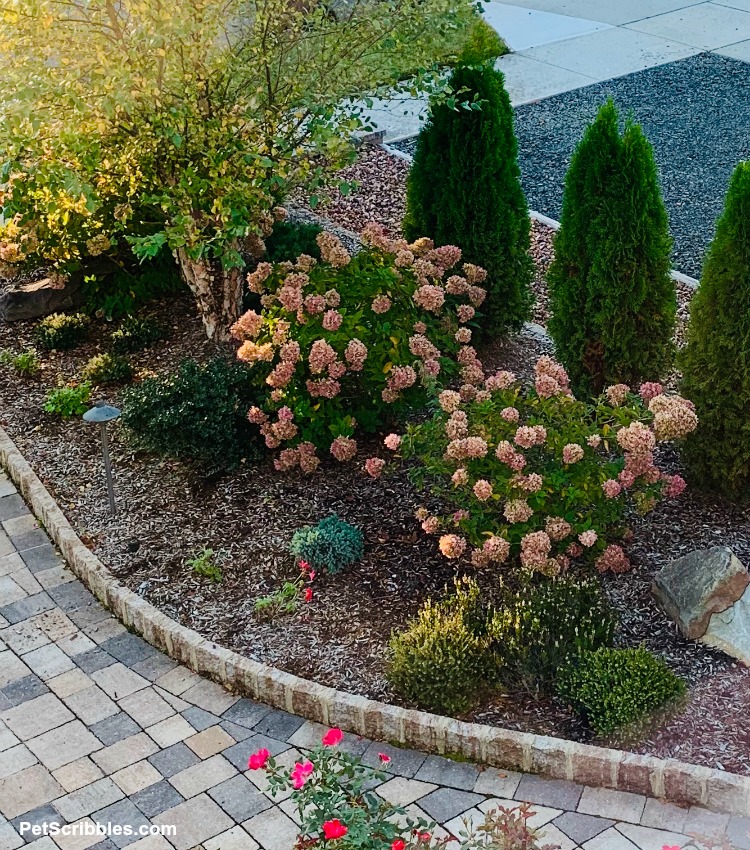
Late October: The flowers begin to fade while they dry on the shrub.
I never do anything special to dry these flowers.
Mother Nature takes care of them all by herself!
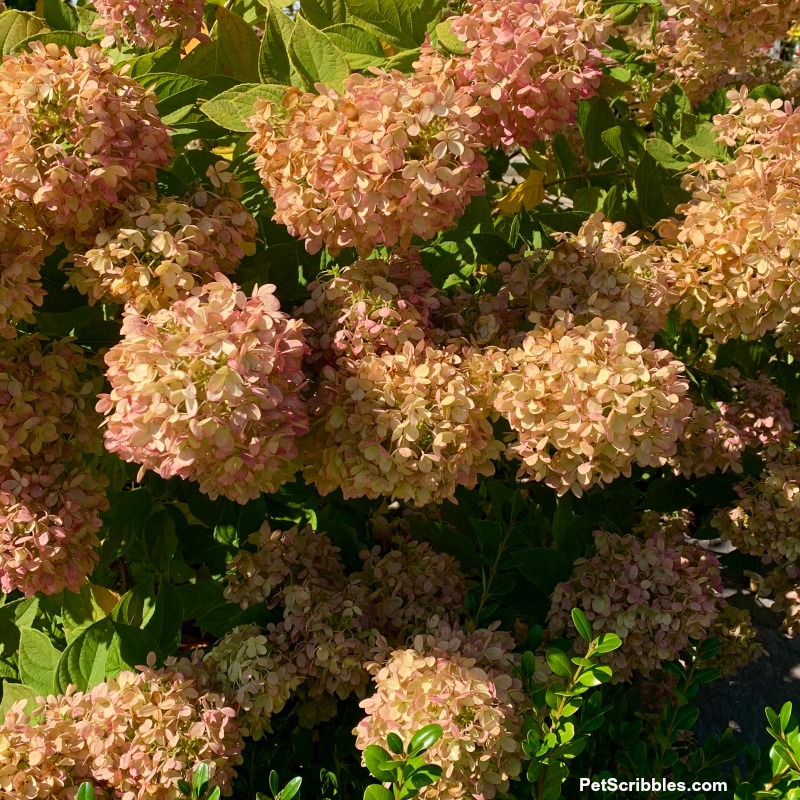
These flowers look even prettier against a blue sky on a crisp Fall day!
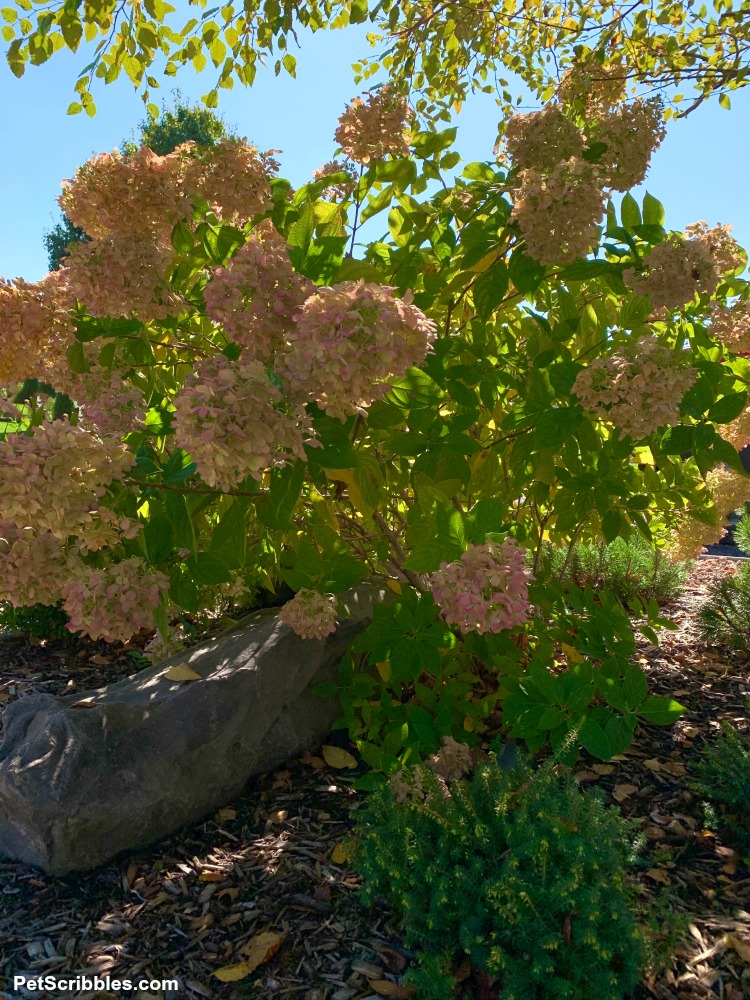
Thanksgiving: By late-November, most of the flower heads have dried.
However, look closely and you will see one that still has its pink color!
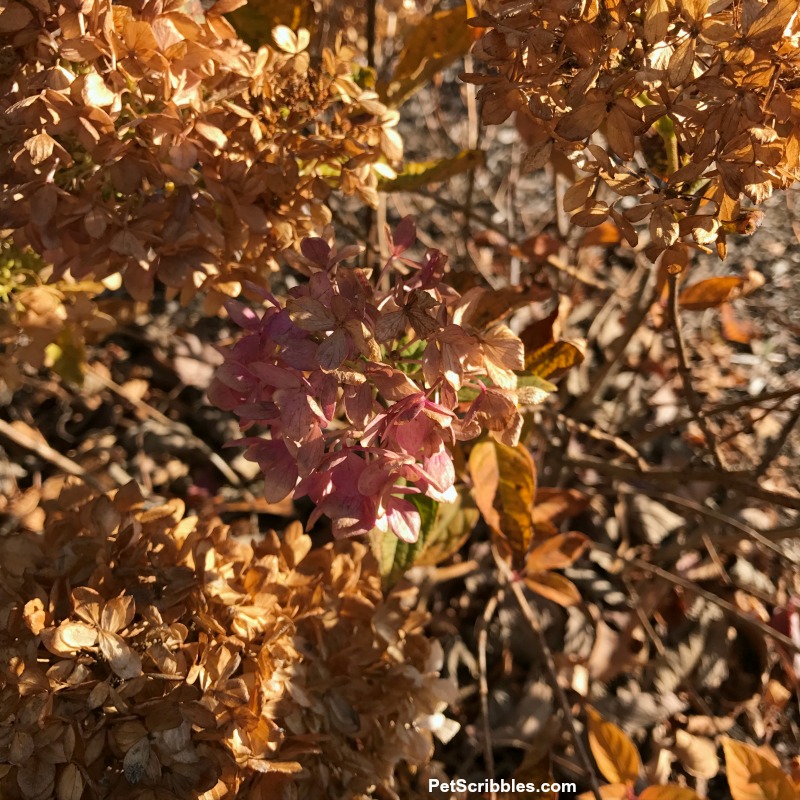
Winter
Mid-February: This Winter Gem Boxwood gets a rusty-brown tinge to it because it is in a very windy, exposed spot.
Even so, the color contrast it provides to the dried Little Lime flower heads, the Red Twig dogwoods and the evergreens nearby is welcome.
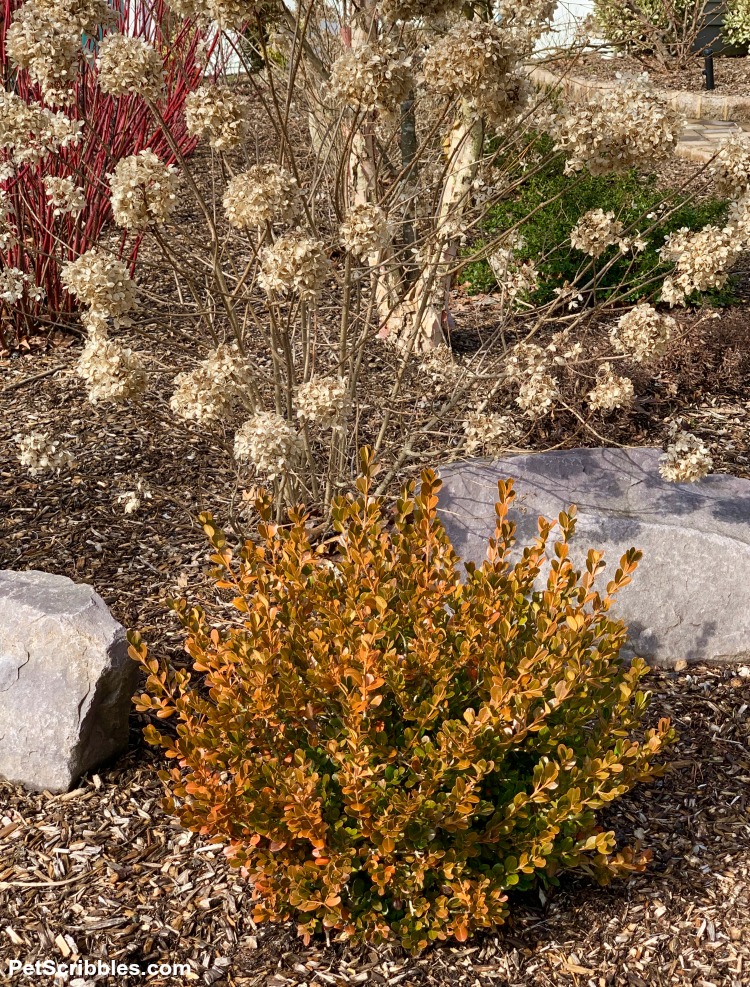
End of March: The boxwood is turning green again, and the daffodils are out!
This is when I say goodbye to the dried flower heads and prune the Little Limes back for the season.
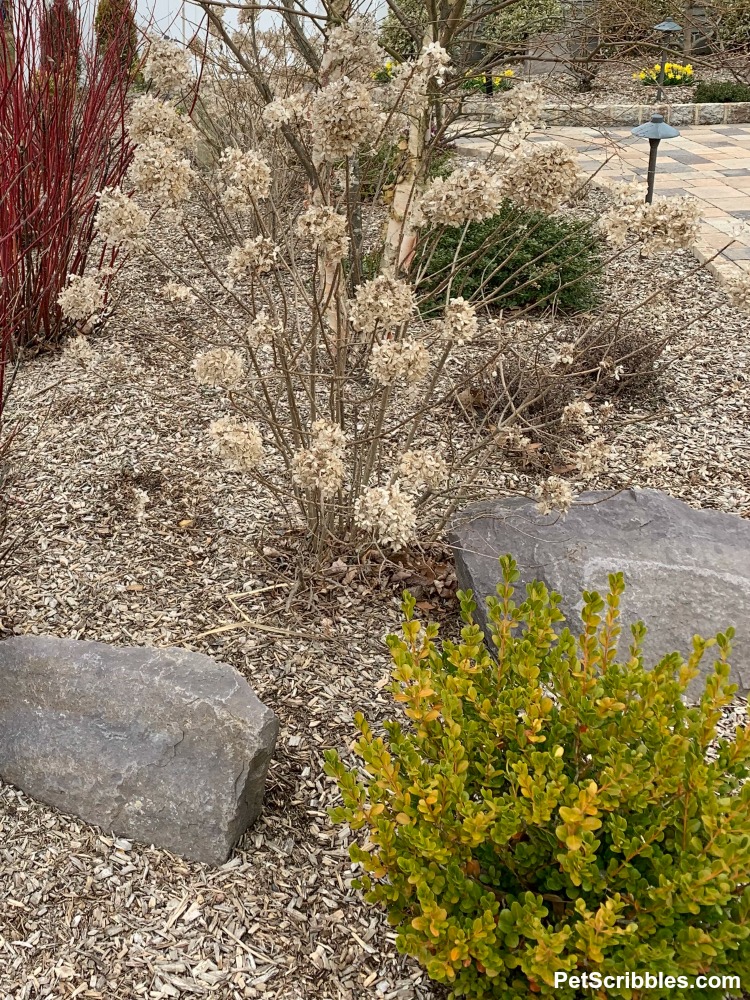
Any time during the Winter when it snows, I’m treated to this lovely display.
The dried flower heads remain on upright stems, and hold the snow nicely!
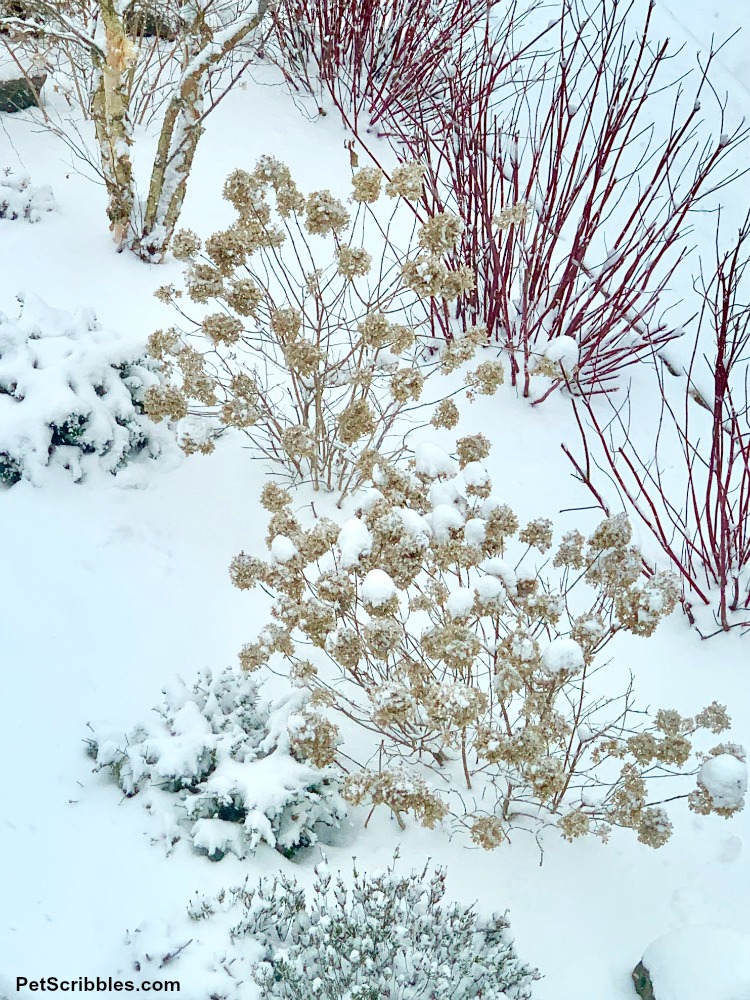
As you can see, Little Lime hydrangea can be used as a four-season shrub.
Add at least one of these to your garden this year.
You will be very happy you did!
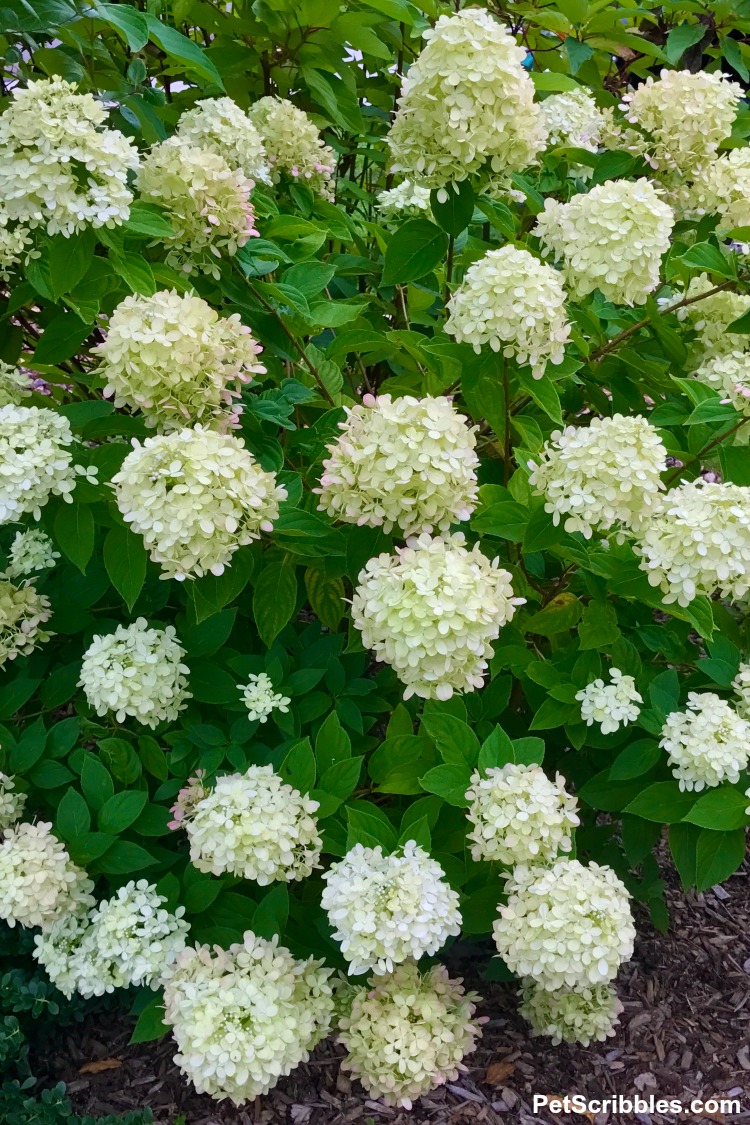
Where to buy Little Lime Hydrangeas
Locally:
My best suggestion?
Visit your local garden nursery.
You will receive expert planting advice from them because they carry plants specifically for your region.
This shrub continues to gain in popularity and many big-box garden centers also carry it now, such as Home Depot and Lowes.
Online:
Happy gardening!

Thank you, this was a very helpful article. Especially the photos and descriptions…just purchased 2 “Little Lime” hydrangea bushes and needed some clarification. Your article answered my questions and then some!
Well thank YOU for letting me know Angi — I really appreciate it! Enjoy the Little Limes and stop back here to let me know how they’re doing later in the Summer!
I TOTALLY LUV what you
Shared…THANK YOU!!
SO… VERY MUCH!!
May I contact..you..
From time to timr!,
If I have any Questions..
SINCERELY Theresa Dilk
I’m so happy that this guide is helpful, Theresa! And yes, you can reach out with any questions!
Such a beautifully written article with seasonal photos even! Thanks! We were looking into Little Lime, and thanks to your lovely article have decided to purchase! Well done! (We’re also in zone 7b!)😁
Thanks Beverly! I appreciate the feedback! I know you will LOVE your Little Lime — or Limes if you bought more than one! Mine are finally open here in southern New Jersey and I’ll be enjoying these flowers well into the Fall season! I wish for you the same enjoyment with yours!
Besides the pretty little lime (thanks, with your article I am confident to put it in my garden now), seen your mulching also very clean without any weeds/wild grass growing. Can you please advise how to keep it clean from weeds and grass? In my garden, around every 3 weeks the weeds come out from my mulching even I have thick layer, but I didn’t put any cover under the mulch to have the mulch decompose into soil.
Appreciate for your feedback. Thanks.
Ah Luki, weeds coming up through mulch is almost worse to me than when I see weeds popping up in a less-than-cared for garden. You spend all that time putting mulch down, making your plants look even better, and then here come the weeds. I don’t use chemical weed killer ever, but I do use Preen, which can be sprinkled around your plants and flowers on top of the mulch. Now, the bad part is that Preen — for some reason — is a light color, so this shows up on the mulch. Preen also makes mulch “with” Preen already in it, so maybe that’s an option for you in the future. I’ve never used it. What I did this year, is before my husband and I shoveled all the mulch onto the beds and spread it around, I sprinkled Preen everywhere. Then we put the mulch on top of that. One thing to note: Preen will help to take care of preventing “new” weeds, but it won’t kill any existing weeds. I still have to do weeding, although it isn’t as bad as it was several years ago. I think over time as I keep repeating the process each year, and more and more mulch gets decomposed and layered on top of the existing soil, it helps reduce the amount of weeds popping up. But believe me: if I let it go for say a week when it is 100 degrees of heat and humidity outside, I’ve got many new uninvited guests in the garden that need to be pulled. On another note, unless it is 90 or 100 degrees outside, I normally find weeding to be relaxing which might sound crazy to some people. I view it as a challenge to “clean up” a small area at a time so it feels less overwhelming. Does this help? I hope so!
Great read and I love all the photos!! I just planted my first dwarf little Limelight this spring and I’m anxiously awaiting for it to bloom next season.
Glad you love the photos Pam! Yes, being patient is not one of our gardening virtues. Just enjoy your Little Lime growing this year and you’ll be rewarded handsomely next year! Keep me posted.
I did a lot of research about this hydrangea. You provided so much detail and I really appreciate the photos. I planted five of them in my backyard. I can’t wait to see the growth next year!!!
Thanks for the feedback MJ! So excited for you having five of them. I only have three and wish I had twenty! If you remember, I’d love for you to keep me posted next year on how they look!
Is it too hot to plant the little limes in August zone 6? I had the limelight’s at my last home as a privacy hedge and I loved them! I want to do them as a foundation plant in front of my new home. it’s a craftsman front porch. Not sure what else to do in front of them. It’s a small area.
Yes, I think it might still be too hot to plant them. I would wait until September after Labor Day to plant them. After planting, make sure to water them thoroughly and frequently, especially if your weather is still hot. I think they will look wonderful in front of your new home. Great idea! Let me know how it goes!
Your article was very helpful. I have one Limelight in my flower bed. I may have cut it back too severely last Spring. The stems are not sturdy enough to hold up the blooms. Ant suggestions for this fall or next year?
Also a landscaper moved this same plant two years ago and placed it closed to the house, which is brick. I live in Alabama. This area gets a lot of hot afternoon sun and the plant has not done as well. Could it be because of the extra heat from the brick?
Thankyou!
Gayle
Hi Gayle,
I’ve heard that pruning Limelight Hydrangeas (much taller than the Little Lime Hydrangeas I talk about here) down too much can, in fact, result in stems that will flop a bit more. Remember that the flowers can hold a LOT of water after it rains, and are slow to dry out, so they will pull down on a stem whether it is weak or strong. That being said, wait to prune until early Spring 2021 — don’t prune in the Fall. When you prune in early Spring, only prune down about 1/3 of the plant and more more. This will result in buds coming out of the thicker stems (below where you made your pruning cuts) and “should” help with the stems being stronger. Just by the fact that the stems are held on a thicker strong base stem, is the theory behind this idea. I’ve read it has worked for others, so hopefully it will help you too.
As for the Limelight being planted near your brick home, it may in fact need more water. Limelights can handle a lot of sun, but do prefer a bit of afternoon shade in hotter climates. Since it was moved two years ago, it’s had at least a season to get acclimated to its new spot. Without knowing what specifically hasn’t been working well, it is hard for me to guess what to do. My best suggestion is to ask a local nursery expert who will be familiar with your climate. I hope this helps!
Laura, Help
I received a Little Limelight for Mother’s Day and planted it in a full sun spot. It bloomed really well but then showed signs of sress. I eventually deadheaded and the plant just seemed to hold its own but didn’t flourish. Also I should mention that our dog urinated on it once or twice before we stopped that problem. So my question now is, should I protect it from the winter here in Michigan. It will be getting the northwest wind. Thank you for any help you can provide.
Hi Caren, The good news is that your Little Lime WILL come back just fine in the Springtime. All new growth from Little Limes comes from either new stems or buds that will grow out of the existing stems, so no worries there. Little Limes go dormant in the Winter, and should be fine in your Michigan area no matter how windy it gets. (Ours endure strong winds during the off-season but they hang in there just fine.) Your dog may have been the cause of the stress you saw on the Little Lime, so here’s hoping that’s all it was. You don’t need to deadhead the plant at all during the blooming season — unless — you want to cut blooms to enjoy in a vase indoors. Sometimes, during the first year of a new shrub, there will be signs of stress. Once the Little Lime is more established, it will be fine. Prune in late Winter or early Spring when you begin to see new buds forming on the stems. Keep me posted next year as I’d love to know how your Little Lime is doing!
Best article on Little Limes I’ve seen. Planted two here in upstate SC this Fall. Hope they will like our red clay and will be able to handle our strong sun. They won’t get any shade until a newly planted Little Gem magnolia grows some. Being a transplant from southern NJ, I have used Holly Tone exclusively on my shrubs & trees for more than 50 years.
Thanks so much Steve! I really appreciate it. Our soil is clay soil here, so I think the Little Limes should be fine for you. They seem happy in any kind of soil as long as they’re cared for. I bet the Little Gem Magnolia will look SO pretty as it grows! Hooray for southern NJ! Yes, when I first moved to NJ, I didn’t even realize Espoma (Holly Tone) was a NJ company. Happy when I found out! Keep me posted next year.
Hi Laura. The two Little Limes I planted last Fall have done very well and are now loaded with flowers. We’ll see how they stand up to our SC sun, heat & humidity this first summer. Our average daily highs are around 90 in July & August and the sun here is so much stronger than it was in Atlantic County NJ.
Hi Steve! I’m so glad to hear it, and fingers cross they handle the SC summer! With the sun already SO strong up here this Summer, I can’t even imagine it being stronger down where you are, but wow! That’s some sun! We’ve already had two heat waves, and last night Tropical Storm Elsa passed through. Amazingly, everything in the gardens looks fine, with one random stem of our Limelight Hydrangea Tree ending up on our patio. (Although there may have been a tornado touch-down in our town I just heard this morning.) Thanks for keeping me posted and I hope the next update from you is that your Little Limes did great! (And hopefully you also get to enjoy the flowers into the Fall season too as they change color and dry!)
Thanks for the information it was all very useful. I am wondering whether the plants need to be spaced 4 to 6 feet apart or can be planted closer together? Any downside to this?
Thanks
Thanks for your question, Kay! Since these shrubs grow between 3 and 5 feet tall and wide, my guess is they would grow into each other a bit, if planted closer than 4 feet together. You will be surprised how quickly Little Lime Hydrangeas fill in and grow during one season. I’m always amazed every year, even though I’d had my shrubs since 2014! If you’re looking to have a “hedge” as in continuous row of blooms, then I’d really try and stick with 4 feet apart. If you were driving a hard bargain, then maybe I’d agree to 3.5 feet apart. 🙂 I hope this helps!
Very helpful article and I LOVE the pics!! Just planted three of these in my big barrel containers with supertunias surrounding them. Hopefully, they make for a beautiful contrast! Question: I had macrophylla hydrangeas on my west side along our fence, but they have only flowered a little, and only a few plants got blooms last year out of 11 planted. I’m in Zone 6B so they fit my area but not sure why they haven’t bloomed. Any suggestions for this year? They are all coming up now, but I’m afraid they will just be green all season.
Oh Julia, those containers with the Supertunias and Little Limes will be stunning! I’m not the best for macrophylla hydrangeas and here’s why: I ripped mine out last Fall. I’d had it! Between the huge amounts of water they require plus just the right mix of sun/shade, and finally the tropical storm last Summer that turned them into a horrid looking mess . . . I was done! LOL And so out they came. One year they were great, the next mostly green leaves, the next too dry, then too wet. I could go on and on. So now all I will plant are paniculata hydrangeas. They are much hardier, and bloom reliably. One suggestion for you is to get a flower booster fertilizer for them. If they get too much nitrogen, they will have stunning leaves but few flowers. Perhaps a boost of some flower food might help? Since you have 11 of them, here’s hoping this will do the trick for you! Fingers crossed they will bloom better this year!
Hi Laura – your article is the most helpful I’ve ever seen, packed full of details and pictures of the progression. Thanks so much for sharing!
You are very welcome, Michelle! I truly appreciate the feedback, as my goal was to put together a complete resource for home gardeners. I love sharing how plants and shrubs will look during their “off” seasons, as too many times we have no idea!
Hi Laura. Just fenced in our backyard at the coast and plan to put in some Little Lime Hydrangea. Can you tell me the name of the 3 tall, column-type evergreen you have planted behind yours? I love the contract and am looking for something tall and narrow for screening that will provide a nice backdrop for the Little Limes. Thanks for the informative article and pictures!
Hi Val, those evergreens are Emerald Green Arborvitaes. They do make a wonderful screen! We added the Arborvitaes to the landscape just a couple of years ago, and I was amazed at how they made the Little Lime Hydrangeas “pop” all Summer into Fall. I hope you’ll enjoy the same thing!
Hi! Was wondering if you could tell me about how tall and wide your little limes get? I am wanting to do a hedge under some windows on one side of our home, and the windows are about 5 feet off the ground, so I know that limelight would be too big! Also saw a “new” variety called limelight prime that get 4-6 feet tall, and I’m not sure whether to try those or go with the little limes! Any advice or suggestions? Thanks!
Hi Ashley, It honestly depends on the “look” you’re going for, as to which type of “lime” hydrangea you choose. My Little Lime Hydrangeas grow between 3 and 5 feet tall and wide. So if you planted those underneath your windows, they would stay nicely below the window. The new Limelight Prime does grow taller as you pointed out. So if you choose this one, know that the flowers may grow “into” your view out of those windows. (That could be a plus, if you want to see those flowers up close!) And you don’t want to prune them once they kick in growing as that will end up removing future flowers. (Pruning is always done in late Winter or early Spring.) As to bloom time, I understand that Limelight Prime begins blooming later in the season than Little Lime. There is a good chart on Proven Winners that shows when each type of hydrangea blooms. If you search for “Limelight Prime Proven Winners” you should find that page, and at the bottom is the chart. I hope this helps! (I’m partial to my Little Limes because they are so easy to maintain, but the new Limelight Prime sounds promising!)
I bought a couple of Little Limelights today and am so excited to get them planted. Thank you so much for all the detail you have posted about them. I did alot of searching on the web and your site answered most all of my questions. I do have one question. Some of the leaves on the plants at the nursery had holes in them like a bug was eating them. The lady told me it was black spot and once it gets it those leaves won’t grow back. She said it needs to be sprayed with a fungicide. Have you ever had this problem? It didn’t look like blackspot to me, but I’ve never grown hydrangeas before so I’m no expert for sure.
Hi Marty, It would be odd to have black spot on the Little Lime Hydrangeas — and even stranger that a nursery would tell you those holes were black spot. They are not. Black Spot doesn’t cause holes at all. The holes — like you said — must be a bug eating them, which could be anything. (By the way, I have a new article on Black Spot, so search for that here on my website — you should find it easily on the front page or in the “Upkeep” section, so you can see what it actually looks like.) I would purchase a “3 in 1” product and spray your Little Limes just to be on the safe side. I use Espoma “3N1” and there are similar products out there. Look for the product to say “3 in 1” and also “fungicide – miticide – insecticide” and that’s what you want. Neem Oil may also be mentioned on the product packaging. This is an organic way to treat your plants for bugs, mites and any fungus that may be on them. Although, I don’t think it is black spot on your Little Limes. I hope this helps, and please keep me posted!
Thank you so much for explaining that so well, and including pics of each season of growth for the hydrangeas (and other shrubs)! That helped me so much! You included every detail I could have imagined, and more! Hope you’re enjoying the summer!
You’re welcome Jadie, and thank YOU for taking the time to let me know. I really appreciate the feedback! It means a lot. I’m enjoying the Summer but not enjoying the heatwaves and high humidity right now. It’s brutal outside! I hope you are enjoying the Summer as well and happy gardening to you!
I enjoyed reading the information you provided regarding the Little Lime Hydrangea. It was very informative. Thank you! I planted several Little Lime Lights and two lime Light ornamental trees last early fall and this year they are all loaded with flowers. They’re just beautiful. However, one of them is flopping and I don’t know if there is anything I can do to remedy the problem. I don’t know if I should prune it down next early spring.
Hi Myrta, First off, all of those “limes” sound so pretty! For the one that is flopping, I have a few questions. Is it one of the “Little” Limes or one of the trees that is flopping? When you say flopping, do you mean that the branches are arching over from the weight of the flower heads? And if it IS the tree, did you recently have rain? The weight of water on each flower head makes them droop a lot more than one would think. Let me know if it’s one of your shrubs or one of the trees that is flopping.
Hi Laura, I think I found the hydrangea expert I was looking for! I’m in “Hotlanta” Georgia and just bought four Little Limelights to add to my landscape. I was planning to wait until fall to get them, but they were marked down and I couldn’t resist. The guys at the nursery said it’s fine to plant them now in all of our late July heat as long as I water them. I’m not sure I believe them. What would you advise? Is it really safe to plant them now? Can I leave them in the pots they came in until fall maybe?
Hi Nikki,
Thanks for the compliment! 🙂 If it was me, I would try and wait at least another month to plant them into your landscape. Maybe mid-August at the earliest. While it is tempting to want to plant them now, waiting until it is cooler is a better option. They will still have time to grow and establish themselves during the Fall season before they go dormant for the Winter. However — IF — and it’s a giant IF — you are willing to keep an eagle eye on them and water them a lot, while also trying not to drown them — you can plant them into your landscape now. Either way — whether you wait or not — you will still need to water them in their growing pots often, each time giving them a deep soaking that runs the water all the way down through the pot and out the bottom. Hydrangeas love water, even these panicle Little Lime Hydrangeas. Personally, I have several shrubs I purchased awhile ago, and they are still in their pots waiting for me to plant them. I’m out there watering them a lot, but I’m going to wait at least a few more weeks before planting. I hope this helps! Keep me posted!
Laura, are you here in GA 7b?
Hi Beverly, I just replied to your other comment, and congrats again on adding Little Lime to your landscape! I’m actually in southern New Jersey at the shore but inland just a bit.
Thank you! I will follow your advice!
Keep me posted Nikki!
All of my little limes (5) are flopping with the huge heavy blooms. What am I doing wrong? They were planted last fall, I pruned branches in spring, and fertilized with holly tone. Foliage grew beautifully but as soon as the blooms came, they all splayed and look like a terrible heap 🙁
Hi Desiree, It sounds like you’re doing everything right! My first thought is: are they getting enough water? How old are your Little Limes? Those are my first questions, as usually the first couple of years these hydrangeas need a lot of water while they get established with good root systems. And even once they are established, they do like to drink a lot of water. Not as much as mophead hydrangeas, but still a good amount. How do the leaves look? Healthy? Let me know and we can try and figure this out together!
Leaves definitely healthy! There is only a few internal yellows toward end of season. Area in yard they are planted doesn’t dry out as often, so I only watered during no rainfall. These were planted October 2020, so only a year in ground and they were 3 gal size. So maybe just their age! I will go through the same process again in spring and maybe try pinching?
I agree with you Desiree: these are young plants and will definitely become stronger with age. Definitely repeat the pruning process in the Spring. If — as the season progresses — there are one or two super-floppy stems you don’t like, definitely remove those flowerheads, and you’ll see those stems bounce right back up. Please keep me posted next Spring/Summer!
Hi there, Laura! I just love your gardens. Thank you so much for your informative articles and photos. I have the same problem that a couple of others have mentioned in the comments — a young Little Lime shrub that got such huge blooms this year that the bloom weight took most of the stems over in deep arcs that ruined the look of the shrub and turned it into a fallen heap. This shrub was planted in Fall of 2019, so this year was its second full year in the ground. The first year, it did not fall over like this as the blooms were all smaller to medium-sized, so until this year there was no problem with the severe stem drooping, well, actually splaying! But this year it grew a lot in height (I’m sure it got at least 4.5′ tall), and most of the blooms were just huge. I could not stand looking at its messy shape any more and cut off all of the largest blooms last month, but unfortunately all those stems had already been burdened with the heavy weight too long and did not stand back up; they are just bent-over stems with the flowers cut off, even though they were all about pencil-thick and none that were tiny weak stems. At least I still had all the other lower stems that contained smaller blooms to still give interest. But I was really upset to have its shape ruined and lose all those flowers, too. I am really unsure about how to proceed for fear of pruning it too much so that it produces a bunch of small weak stems and happens again next year. However, I just can’t leave all these permanently-bent stems standing out as it looks bad. Even though it is still a young shrub, if you look down inside to see the middle, the main “trunk” with its branches have already become woody, tough and sturdy-looking, and I don’t have hardly any branching coming from the very bottom at ground level, so I don’t see any buds coming from down. Oh, you’ll probably want to know — it is planted on the east side of the house with morning sun up until early- to mid-afternoon when the shade comes around. It is mulched and has not ever had any problems with having any yellow leaves from being too dry. No leaf spots or any troubles, and the leaves always look good. I have put supplemental water on it occasionally in the hottest weather; otherwise, it fends for itself. Everything in that bed looks to have just the right amount of moisture, leaning toward the dry side, not too damp. I have used Holly Tone sparingly, only once in the spring. I prefer the natural look on shrubs in general, and I have only pruned off the dead blooms in Spring 2020 and Spring 2021, so the branches have been allowed to grow naturally. I have a real dilemma wondering what I should do to fix this huge heavy blooming problem with severely arching stems. What would you suggest?
Hi Kaye, The drooping it something that can be fixed, so no worries! Before I get into the pruning aspects, I want to compliment you as it sounds like you are doing everything right, and the Little Lime shrub is planted in a good spot and getting enough sun and water. Never worry about using too much Holly-tone because it is a slow-release fertilizer. This means it doesn’t work like synthetic fertilizers such as Miracle-Gro that blast plants with an onslaught of food. Holly-tone is more mild, and because it releases food gradually over time, you can give a good amount to your Little Lime and not worry you’re over-feeding it. 🙂
Now, in terms of the shrub itself, I think it needs a good pruning in early Spring. I have a step-by-step in the guide above, but there’s also a link to a video I did on pruning, where I show you examples of how I prune my own Little Limes. The first time you prune your Little Lime, it might seem overwhelming at first — but don’t be nervous. It’s easy to prune this shrub AND since all of the flowers appear on new growth, you won’t be cutting off any future flowers. The curved branches can be cut back a bit, and wherever you make your cut — at least two new branches will grow from that area, as long as you make the cut near a set of buds. (Again, you can refer to the images in my guide above to see what those leaf nodes or buds look like — and I also show them in the video.) Pruning will encourage more stems to develop and grow out from those larger stems. From those stems will be flowers and lots of them, in small sizes and larger sizes. If you look at another video of mine, called “little lime hydrangea garden tour” — you’ll see I have flowers in all sizes on my shrubs. Yes, some stems will droop a bit, but this tends to happen in younger plants. (Little Limes are very different from Limelights, as Limelights are very prone to drooping from the weight of their large flowerheads.)
If you can’t stand how those curved branches look from now until early Spring — you can trim them back a bit right now, just to make the shrub look better for you. When you look at my Little Lime Hydrangeas in the “hydrangea garden tour” video — it may look like they are all naturally growing nicely, but a lot of careful pruning was involved in the Spring. The good news, however, is that once you do this pruning every Spring — and once your Little Lime goes through another season or two, you should be all set! Prune, then Holly-tone….then you should be fine! I hope this helps?
Hi Laura,
Thank you so much for your Little lime hydrangea guide! I have just purchased two of them and hoping to plant them on the front lawn. Your guide was truly helpful.
I did have a question regarding the location of planting them. I have quite a bit of room closer to our front porch as there was a previously cut-down juniper tree/shrub and the stump was left and is still on the ground. Could I plant these little lime hydrangeas right in front or beside the stump? Do little lime hydrangeas have shallow roots? I want to ensure that the stump and root system doesnt hinder the growth of the hydrangeas. Thank you so much.
Thanks for your feedback on my Little Lime Guide, Frances! I appreciate it! If it was me, and I wasn’t planning on keeping the stump visible for any decorative, rustic purposes — I’d pay to have the stump removed, which would include the roots below ground. It’s worth it long-term, because then when you plant your Little Limes, you don’t have to worry about anything. The Little Limes can just grow and get established and enjoy their permanent home dressing up your front lawn! I can’t say for sure if the juniper roots would hinder the root development of the Little Limes, but I don’t think they’d help. So that’s just my opinion and what I would do. I hope this helps you!
Hi Laura,
Thank you for your response and advice. We are certainly looking into getting the stump removed. However, the arborists we’ve spoke to mentioned that they are only able to do stump grinding up to 8″ below grade and with a 12″ diameter from the stump, rather than full removal. I will try to remove as much roots as I can but hopefully the stump grinding and some of the root grinding/removal will help my little lime. I will also try to plant it as far as possible.
I plan to amend the soil around that area, would you know if hydrangeas do best in neutral or acidic soil?
Thanks again for all your advice and help!
Hi Frances, I hope — as you say — that with the stump grinding it will help your Little Lime. These hydrangeas love acidic soil, so my suggestion is to plant your Little Lime as normal, and add a slow-release fertilizer like Espoma Holly-tone, which is for acid-loving plants. Sprinkle it around the drip line of your Little Lime — where water naturally drips off the plants after it rains — and it will soak into the soil over time. That should be all you need to do! I hope this helps! Please keep me posted!
I have a row of limelights that are not blooming – all green leaves no buds. They bloomed a bit last year and was hopeful they would produce more this year. Last year they were hit bad by the deer so I thought that was reason for little blooms then. They get full sun and are planted in front of a hedge that is approx. 12 feet tall. Mulched area. Can I fertilize in July heat? my neighbor has some on the opposite side of the hedge and they are blooming. Cannot figure why mine are not? My regular hydrangeas ( I think they are everblooming something like that are blooming but also hurting – limp like not thriving) the humidity has been bad here so maybe that is why. Any help or advice would be appreciated.
Thanks
Hi Kim, I’m so sorry your Limelights aren’t blooming. It has indeed been a brutal Summer! If the deer are not eating them this year, I’m unsure what exactly could be causing the lack of blooms. When did you prune them this year? Sometimes if pruning too late in the Spring season, you can accidentally end up removing the flower buds. Are they younger plants, in other words planted in the last year or two? Sometimes it takes Limelights a few years to get established and then they will take off with flowers blooming. It’s good they are getting full sun. It’s usually not a good idea to fertilize this late in the season — however — adding a slow-release organic fertilizer like Holly Tone is ok because it will slowly improve the soil and nourish the plants. Another possibility is too much nitrogen in the soil, perhaps from grass fertilizer nearby, which results in lots of green leaves but no (or little) flowers. Keep an eye out for deer, as they can easily chew off the flower buds too. I hope this helps!
When is the best time of the winter is it to cut hardwood for propagation of the Little Lime plants and when is the best time for softwood?